
Visitor Use Management Plan for the Lake Louise Area
Banff National Park
First Phase Complete
The first phase of consultation on visitor use management planning for Lake Louise is now complete. This phase collected input on desired conditions and aspirations for the Lake Louise area. The next phase of consultation will focus on strategies and actions or how to achieve the desired conditions.
The next phase of consultation is anticipated to take place in spring 2025.
Introduction
We need your help to shape how Parks Canada manages how visitors use and access the Lake Louise area.
Parks Canada’s mandate is to protect and share these special places. In recent years, conserving and ensuring access to Lake Louise has become more complex. Increasing congestion and crowding detract from the experience of visiting. This can make timely emergency responses difficult and also impacts wildlife, water quality, facilities, and infrastructure.
How can we best provide safe public access and high-quality experiences while conserving the ecosystems and natural splendour that make this place so special?
Parks Canada has used many tools to address this challenge such as shuttles, reservations services, paid parking, and behavioral marketing campaigns. We have learned a lot over the years—now, we would like to hear from you.
How to have your say:
The first phase of consultation on visitor use management planning for Lake Louise is now complete. This phase collected input on desired conditions and aspirations for the Lake Louise area.
- What We Heard – Executive Summary – Phase 1: Validating Draft Desired Conditions
- What We Heard – Full – Phase 1: Validating Draft Desired Conditions
The next phase of consultation will focus on strategies and actions or how to achieve the desired conditions. The next phase of consultation is anticipated to take place in 2025.
- Step 1: Review the background information.
- Step 2: Watch for engagement opportunities in spring 2025.
What We Heard: Lake Louise Area Visitor Use Management — Phase 1: Validating Draft Desired Conditions New
Executive Summary
Project engagement timelines
Fall 2024
Validate desired conditions
Complete
Spring 2025
Engage on draft strategies and actions
Summer 2025
Finalize plan
Fall 2025 Onwards
Implement, evaluate, adjust
Purpose and scope of plan
The Lake Louise Area Visitor Use Management Plan will provide Parks Canada with a long-term approach to managing visitor use in the Lake Louise area in a way that protects nature and history, is safe for visitors and staff alike, and provides a positive experience when visiting.
The visitor use management planning process will provide Parks Canada with the tools and tactics needed to achieve these goals. The plan will promote safe and efficient visitor movement and transportation in the Lake Louise area, with a focus on peak visitor season (May to October). It will be iterative and adaptive in nature and will:
- Articulate key attributes and values in the Lake Louise area.
- Document key issues and concerns in the Lake Louise area.
- Summarize current conditions in the Lake Louise area.
- Confirm desired conditions to achieve.
- Define strategies and actions to achieve desired conditions.
- Outline a strategy for monitoring and assessing the effectiveness of actions in achieving desired conditions.
This plan focuses on the Lake Louise area (see map below) including Upper Lake Louise, Moraine Lake, Paradise Valley, the Lake Louise Park and Ride, and the transportation corridors that link them. The community of Lake Louise itself is addressed through the Lake Louise Community Plan. A separate process to update the community plan is also underway.
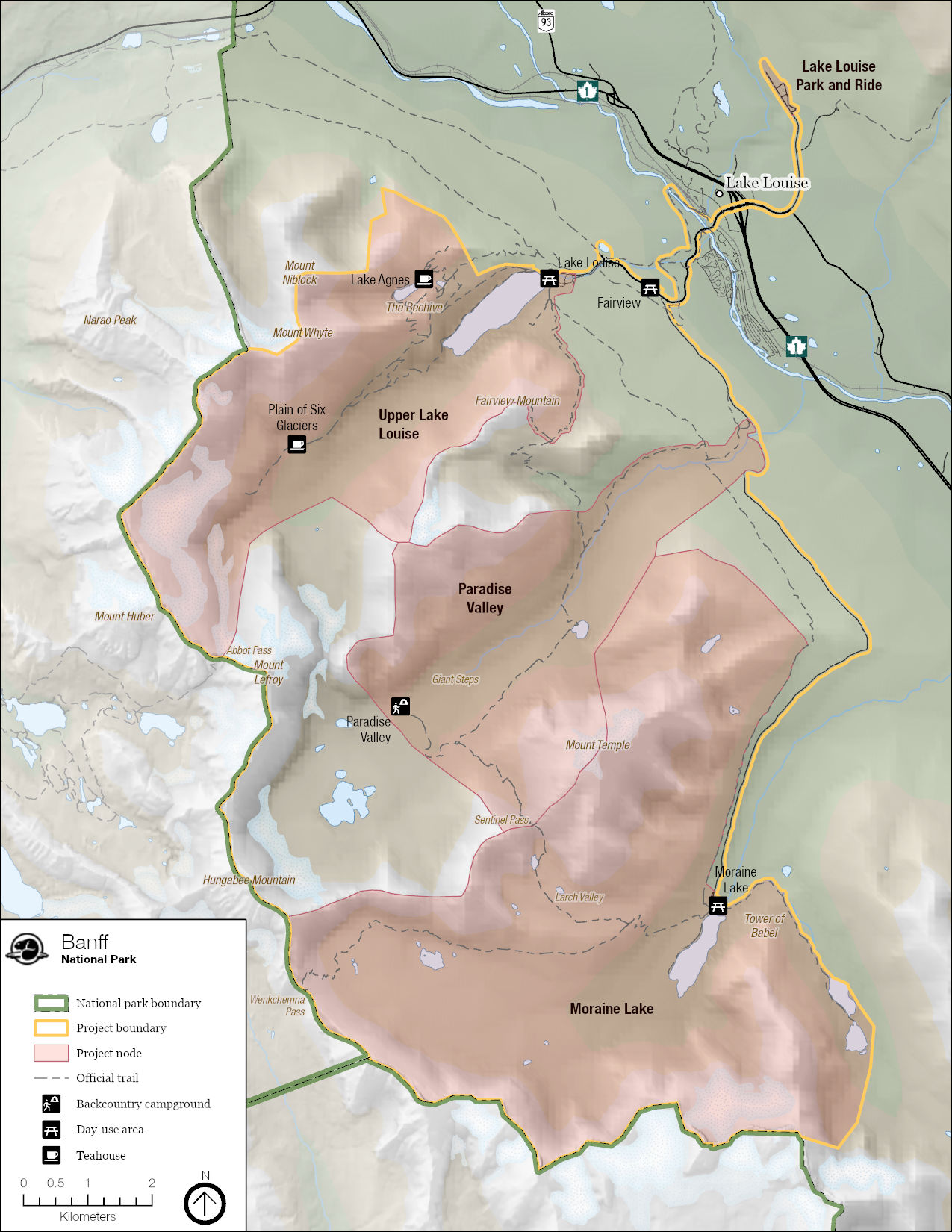
Map description
A map of the Lake Louise area outlining the boundary of the plan and 5 key visitor use nodes: Upper Lake Louise and the surrounding trails, Moraine Lake and the surrounding trails, Paradise Valley, the Lake Louise Park and Ride, and the transportation corridors that link these key nodes. The community of Lake Louise is not included in the project area.Back to top
Significance of the area
Value statements express which resources and values are most important and authentic to the Lake Louise area. Some of the attributes that make the Lake Louise unique include:
- A wide variety of recreational opportunities: The Lake Louise area is a premier destination that provides many recreational experiences. Visitors to the area stroll alongside glacial lakes, hike through golden larches, paddle through mountain lakes, and climb peaks in the backcountry. There are options for groups of all sizes and abilities.
- Outstanding viewscapes: World renowned views of turquoise lakes, glaciers, mountain peaks and golden larches attract amateur and professional photographers from around the world.
- Vital wildlife corridors: The Fairview and Whitehorn wildlife corridors provide critical habitat for large carnivores to travel through the area, find mates and food. Grizzly bears, wolves, and lynx are a few of the species that use these corridors.
- Alpine and subalpine ecosystems: Ecosystems contain lakes, meadows, forest, and habitat for sensitive species. The area is home to a wide variety of plants and animals, including sensitive species such as grizzly bear, wolverine, whitebark pine, little brown myotis, barn swallow, and western toad.
- Culturally significant area for Indigenous peoples: The Lake Louise area lands and waters have been used for millennia by Indigenous peoples for sustenance, ceremony, trade, and travel.
What experiences in the Lake Louise area are most important to you?
The first phase of consultation on visitor use management planning for Lake Louise is now complete. This phase collected input on desired conditions and aspirations for the Lake Louise area. The next phase of consultation will focus on strategies and actions or how to achieve the desired conditions.
The next phase of consultation is anticipated to take place in spring 2025.
How we got here
Banff National Park visitation has grown 31 percent over the last decade. Banff National Park saw 4.28 million visits in 2023/24, the busiest year on record. The Lake Louise area has seen an even more pronounced increase in visitation. For more than a decade Parks Canada has been managing increasing traffic congestion, caused by rising visitation. This requires a multi-pronged approach. Each management strategy has allowed Parks Canada to make incremental progress and iterative improvements.
Key milestones of our visitor use management efforts to date include:
2013 | 2016 | 2017 | 2019 | 2020 | 2021 | 2022 | 2023 | 2024
2013
Parks Canada shuttle to Moraine Lake begins!
High demand for access to the Moraine Lake area during larch season prompts Parks Canada to provide shuttle services to Moraine Lake over two weekends in the fall.
2016
Lake Louise shuttle route added, roadside parking difficulties
Congestion impedes emergency vehicle access on Lake Louise Drive. Parks Canada expands the shuttle service to Lake Louise over weekends in July and August. Contracted traffic control personnel are present on site daily, throughout summer months. The Moraine Lake parking lot is routinely over capacity and vehicles park along the shoulder for several kilometres.

2017
Lake Louise shuttle route expands to provide daily service, extreme congestion on Lake Louise Drive, trip planning communications take off
Parks Canada expands the Lake Louise shuttle route to 7 days/ week during summer months to address midweek congestion. Moraine Lake shuttle route continues during the fall. To help reduce the number of personal vehicles at Lake Louise, Parks Canada contracts a private, third-party bus service to connect the Town of Banff to the Lake Louise area.
During peak periods, traffic is restricted from travelling on Moraine Lake Road when the parking is full. Traffic movement is not restricted on Lake Louise Drive. However, congestion remains high during peak periods and periods of gridlock result in delayed shuttles and impeded access and egress for visitors and emergency services. Congestion also becomes a barrier to wildlife movement.
Parks Canada, Town of Banff, and Banff & Lake Louise Tourism create a joint marketing partnership to encourage visitors to plan ahead and to create awareness of transit options to and within Banff National Park. Visitors are strongly encouraged to take transit, arrive early, visit at non-peak periods, or visit alternate park locations. Communication tactics include live parking updates, trip planning tools, media exposure and advertising tactics including radio, digital and print.
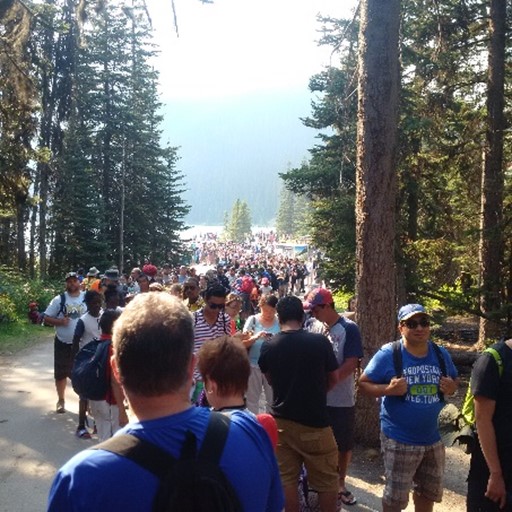
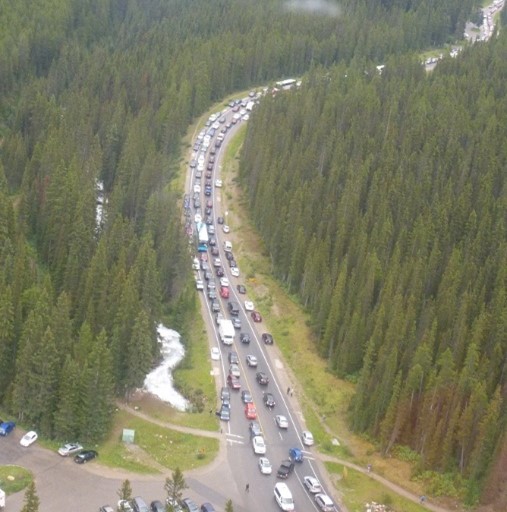
2019
Moraine Lake shuttle expands to daily summer service, visitors face 3-hour lineups, fee introduced for shuttles
From June to October, the Parks Canada shuttle runs daily to each lake, every 15 minutes. Shuttles operate on a paid, first-come, first-served system from the Lake Louise overflow parking lot, 5 km east of Lake Louise on the Trans-Canada Highway. A connector shuttle transports visitors from Upper Lake Louise to Moraine Lake. Lineups to board the shuttles reach 2-3 hours long. There are limited amenities, and parking at the Park and Ride is over capacity, creating concerns around safety on the Trans-Canada Highway.
Upper Lake Louise and Moraine Lake parking lots fill by 7 am and traffic congestion is a regular occurrence. Parks Canada partners with Roam Public Transit to launch routes 8X, 8S and 10. The routes service the Lake Louise area from the Town of Banff.
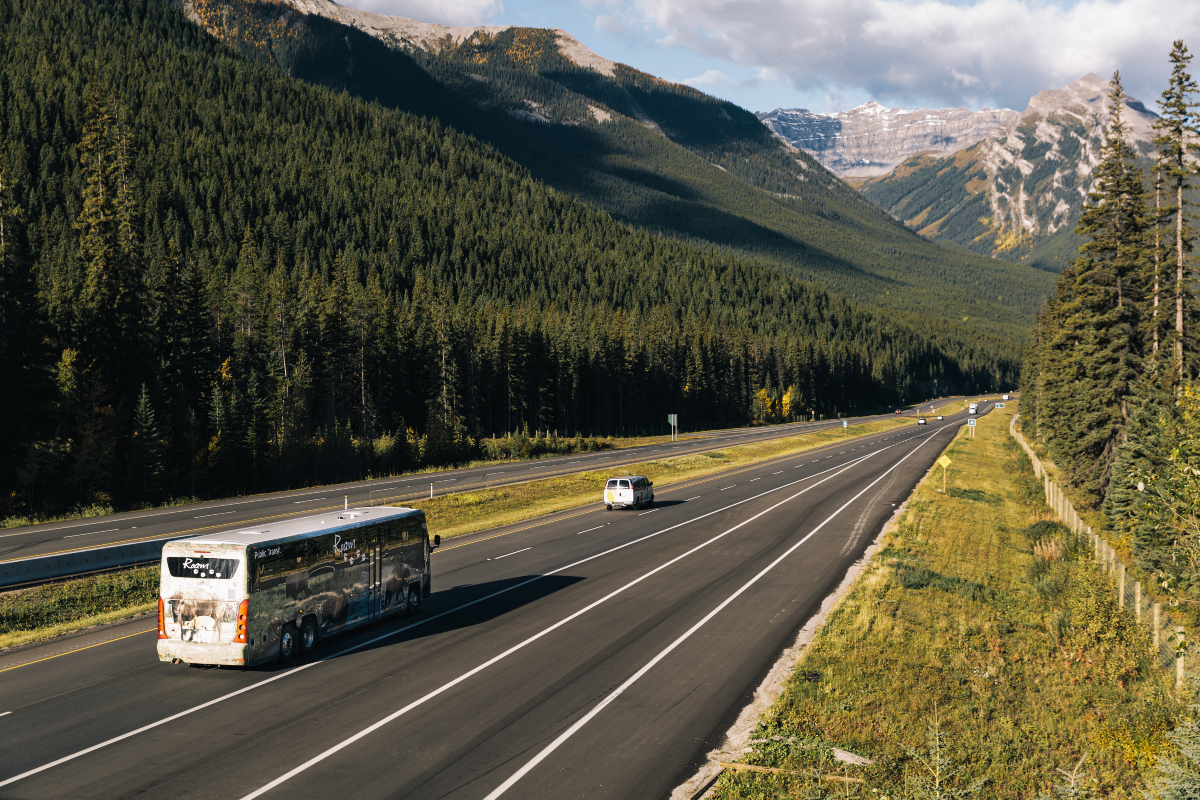
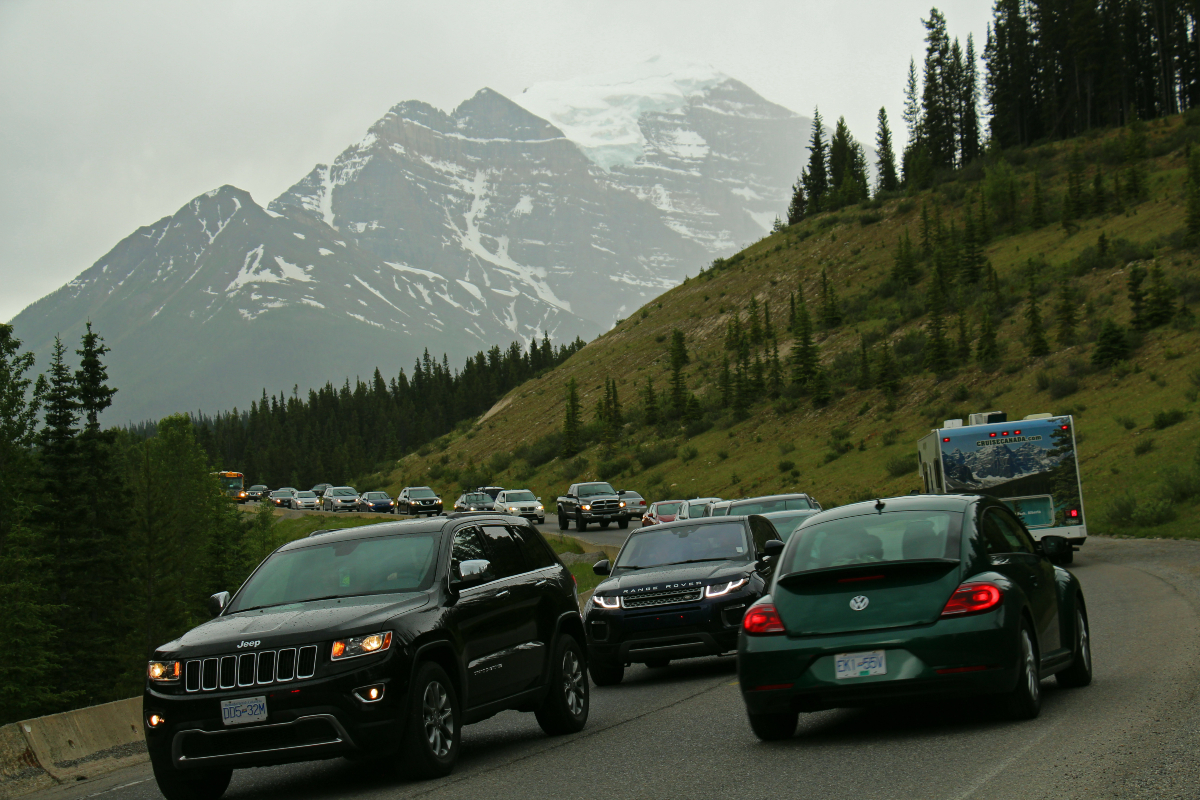
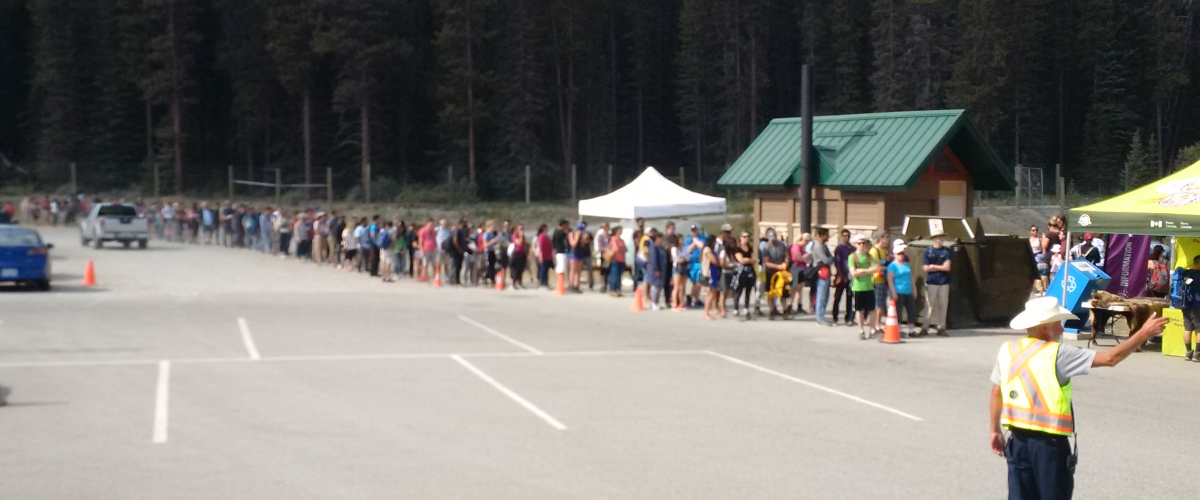

2020
COVID-19 Pandemic and Moraine Lake receives new washrooms
The Parks Canada summer shuttle is cancelled due to the COVID-19 pandemic. The shuttle resumes service to Moraine Lake in the fall. Parks Canada builds 10 new toilets at Moraine Lake.
2021
Shuttle reservation system introduced, and visitors must pay to park at Upper Lake Louise
The shuttle reservation service spreads visitation throughout the day and reduces lineups for shuttles. Parks Canada significantly increases Moraine Lake shuttle capacity by adding a direct route from the Lake Louise Park and Ride. The connector shuttle between the lakes allows visitors to see both lakes in the same day. Paid parking ($11.70/ day) is in effect in the Upper Lake Louise parking lot during the shuttle season to help incentivise transit use and offset the cost of the shuttle program. However, it remains less expensive for most visitors to park than to ride the shuttle. Visitation is still rebounding from the COVID-19 pandemic and shuttles operate below capacity.
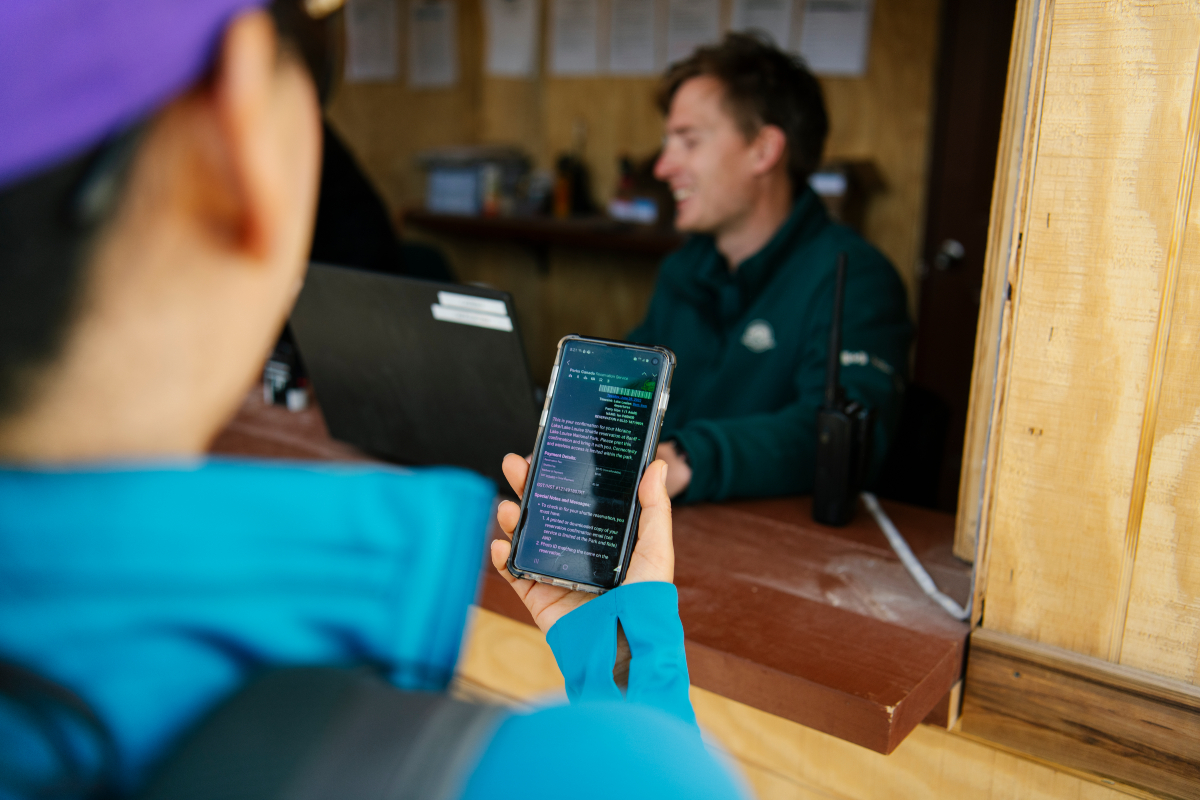
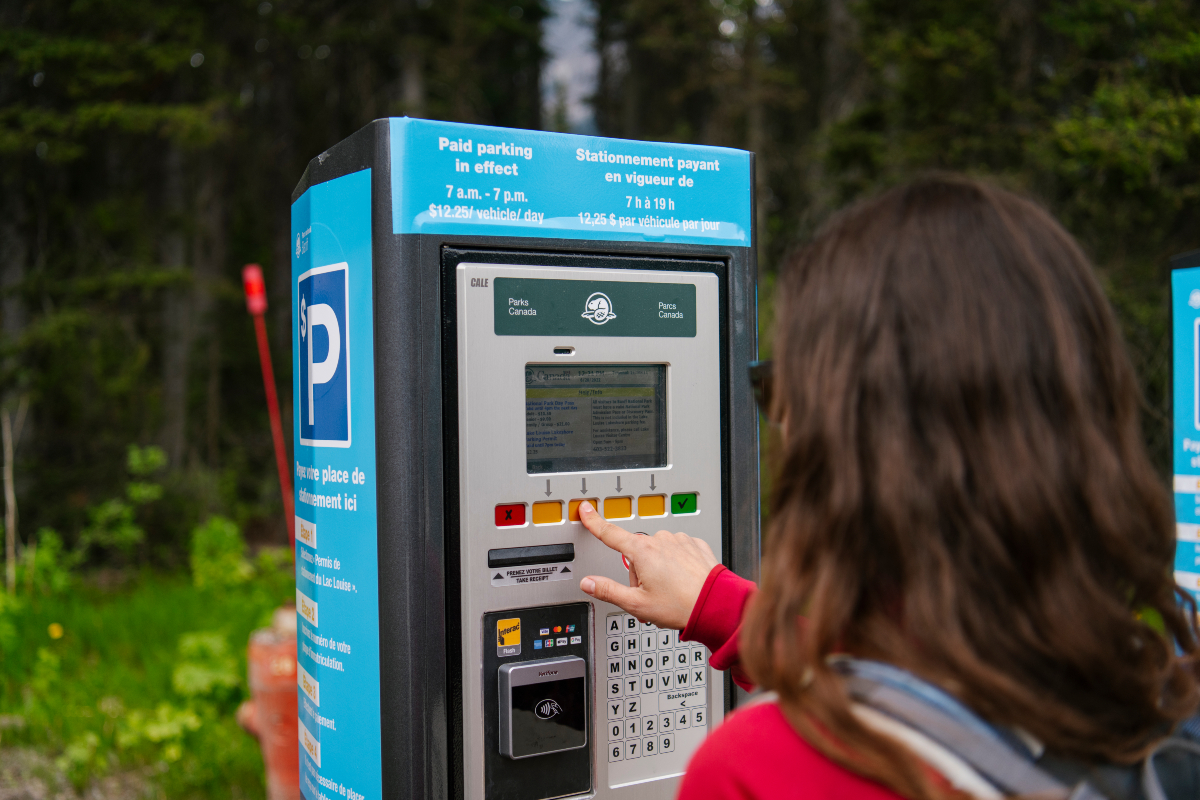
2022
Park and Ride relocated, Moraine Lake parking filling by 4 am
The Lake Louise Park and Ride is relocated from the overflow parking area to the Lake Louise Ski Resort. This increases parking space and improves access to and from the Trans-Canada Highway. Whitehorn Road is closed to vehicles overnight to mitigate impacts on the Whitehorn wildlife corridor.
Great Divide parking lot on Lake Louise Drive and key sections of the Bow River Loop Trail are closed seasonally to help condense the human footprint and therefore limit disruptions in the Fairview wildlife corridor. This provides more space for wildlife using critical habitat patches in the Lake Louise area.
Paid parking at Upper Lake Louise is increased to $12.25/ day.
Parks Canada partners with Roam Public Transit to integrate route 8X riders with the Parks Canada shuttle service by allowing Roam Public Transit riders to connect to Moraine Lake on the Parks Canada Lake Connector shuttle.
Parks Canada shuttles sell out most days in July and August. Moraine Lake parking lot routinely fills by 3 am or 4 am Traffic control personnel are required 24 hours a day to prevent overcapacity issues. An average of 5 000 vehicles per day are turned away from Moraine Lake while only 700 to 900 vehicles per day can park at the parking lot. The unpredictability of the system results in significant visitor frustration. Abuse and violence are frequently directed towards Parks Canada traffic management staff and contractors.
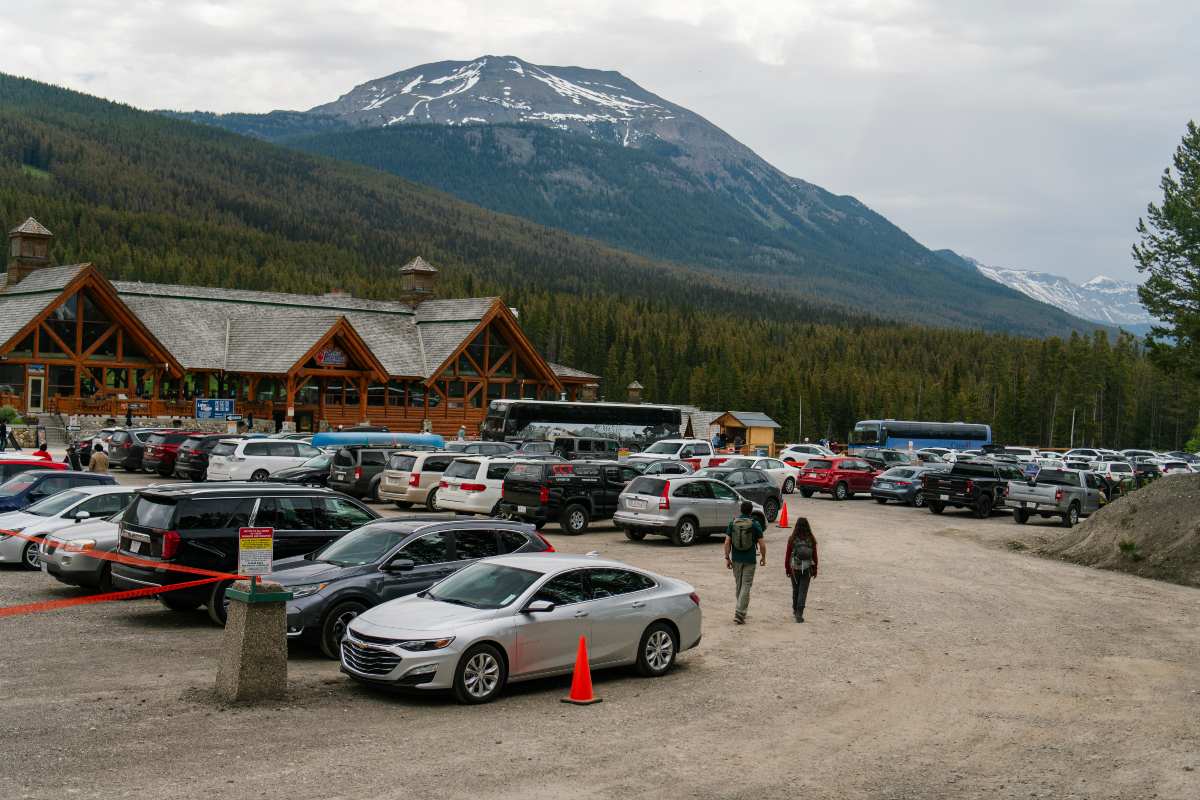
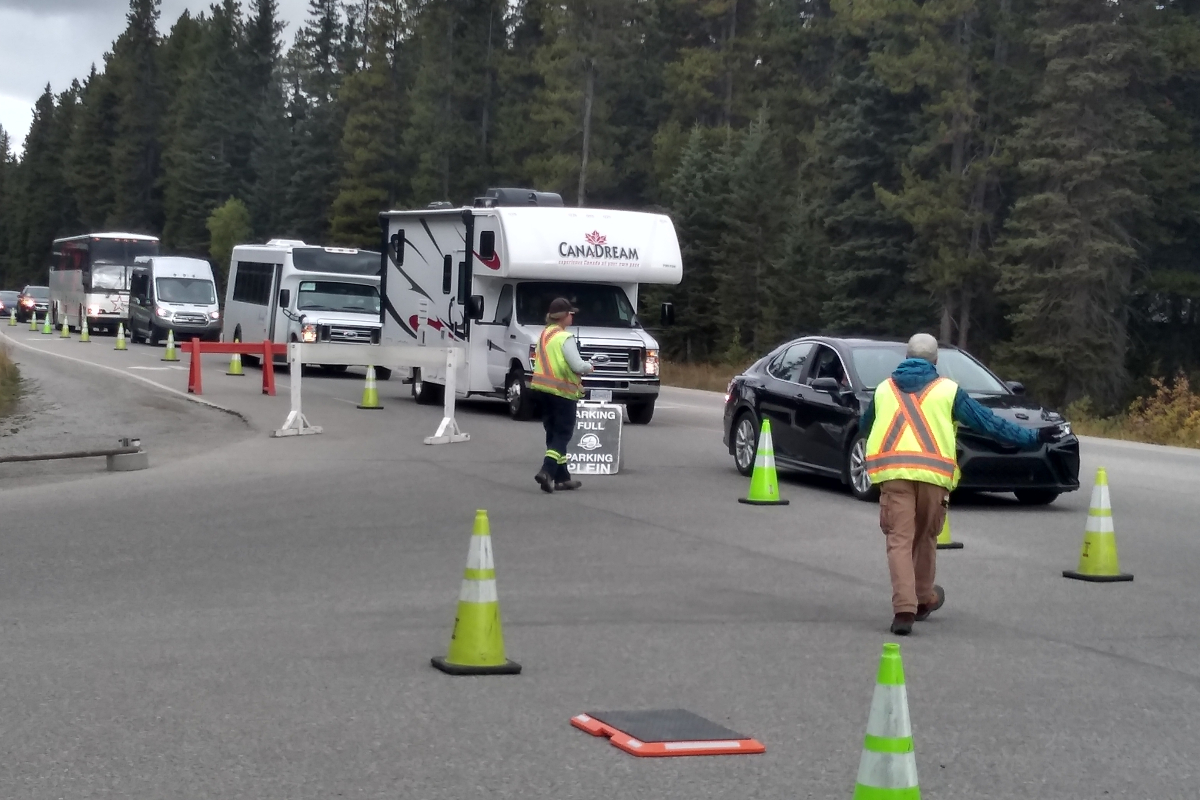
2023
Personal vehicles restricted from Moraine Lake Road
After having had to turn away 85 percent of vehicles attempting to park at the Moraine Lake Road in 2022 because the parking lot was full, Parks Canada restricts personal vehicle access to Moraine Lake. Public access to Moraine Lake is provided by Parks Canada shuttles, Roam Public Transit, and commercial vehicle operators. The Moraine Lake parking lot now operates at or near capacity, with minimal congestion. Commercial buses must have a minimum 11 seats. This is a requirement for guided services, tour buses and third-party shuttles.
Paid parking at Upper Lake Louise increases to $21/ day. This makes the fee slightly higher than the cost for a family to ride the shuttle.
These actions result in a 23 percent reduction in traffic volumes on Lake Louise Drive compared to 2019 levels and a reduction of vehicle traffic on Moraine Lake Road during sensitive wildlife hours. Despite the significant reduction in traffic, the Upper Lake Louise parking lot operates over capacity from 8 am to 6 pm most days during June to September. Congestion on Lake Louise Drive continues. Approximately 1 800 vehicles are turned away from Upper Lake Louise every day during the summer. Parks Canada shuttles run every 15 minutes between 6:30 am and 8 pm and sell out every day from mid-June to mid-September.
A new wildlife underpass on Whitehorn Road funded by the Lake Louise Ski Area in accordance in its Long Range Plan improves the safe passage of wildlife through the Whitehorn wildlife corridor.
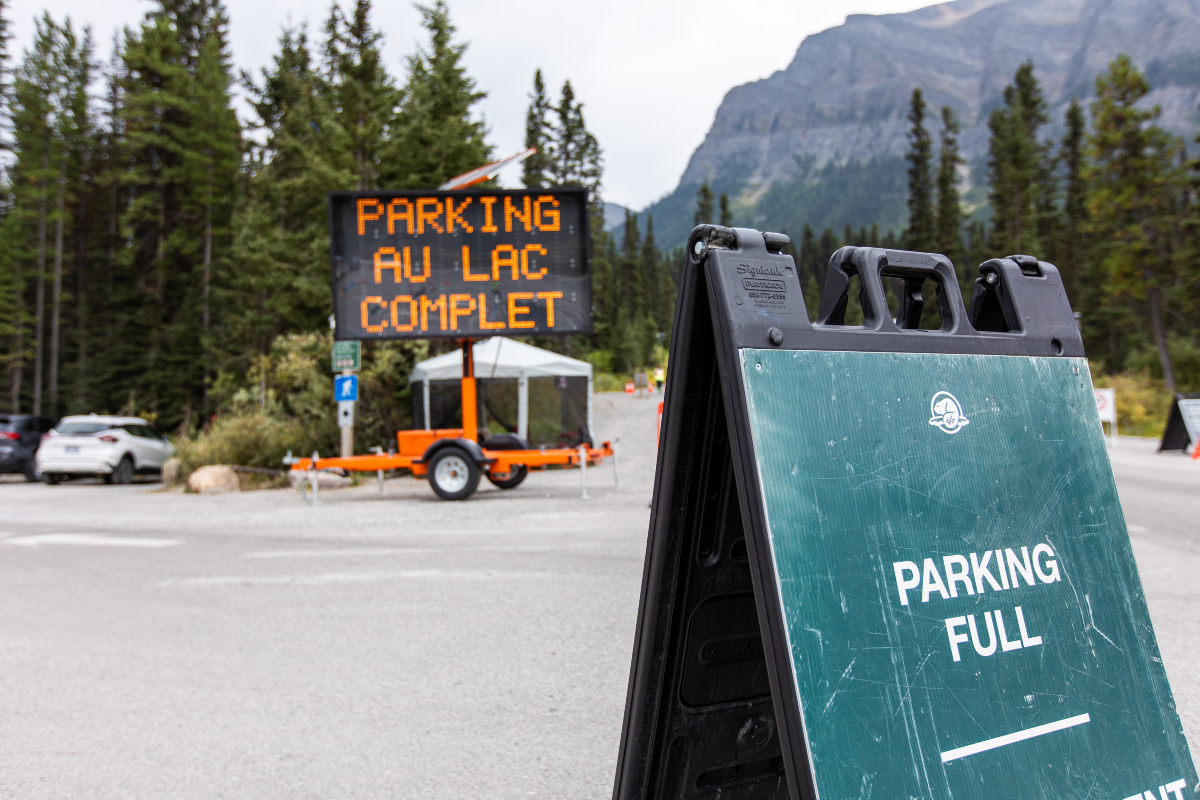
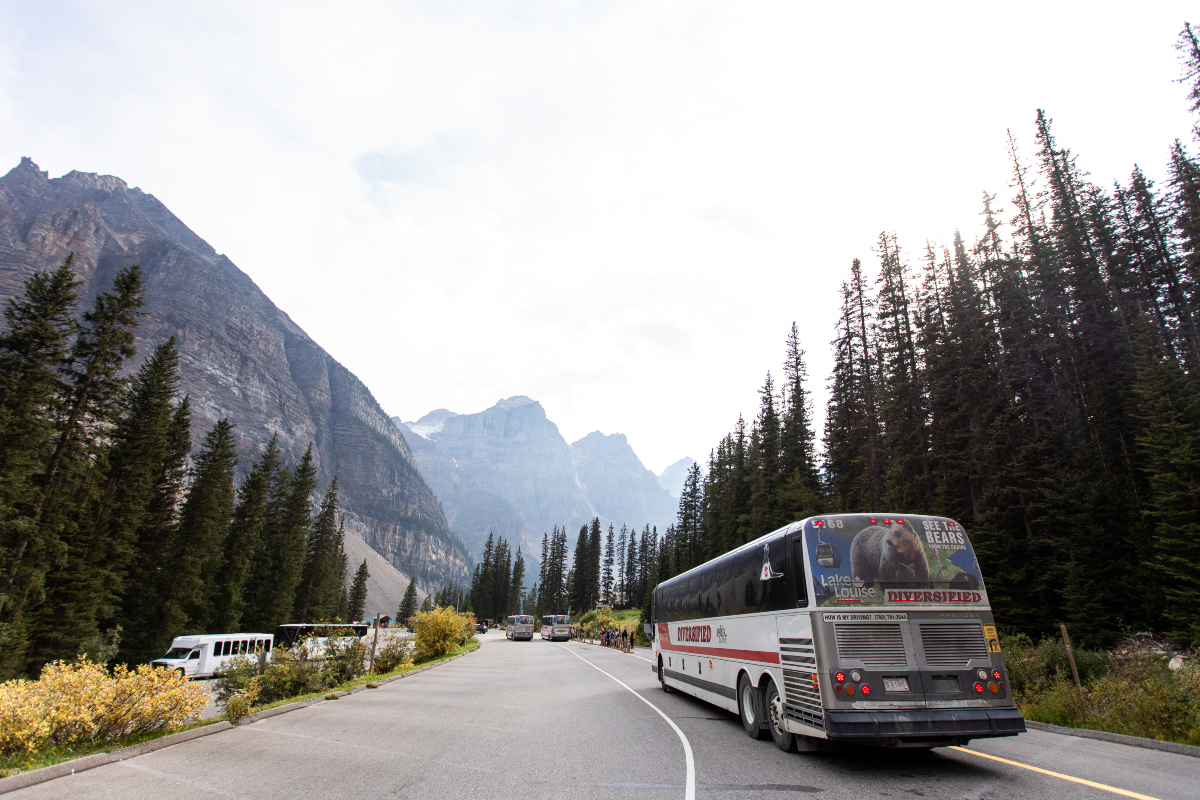
2024
Alpine start route added and pay parking increases again
A new alpine start shuttle departing for Moraine Lake at 4 am and 5 am facilitates access for early morning users (e.g. climbers, mountaineers, sunrise seekers). Paid parking at Upper Lake Louse increases to $36.75 per day. This brings it in line with comparable parking fees in the region and creates a clear financial incentive to take the shuttle, as recommended by the Expert Advisory Panel on Moving People Sustainably in the Bow Valley. On-it Regional Transit begins offering a direct route from Calgary to Lake Louise. Lake Louise Drive undergoes a rehabilitation and modernization project. This includes road resurfacing and the redesign of key intersections to improve traffic flow, wayfinding and pedestrian safety.
The current Parks Canada shuttle system has a daily capacity of 2 860 inbound riders per day. Shuttles are expected to sell out during June to September. Roam Transit and private shuttle operators are adding significant additional capacity daily. The parking at the Lake Louise Park and Ride is expected to reach capacity.
Current context
Key ecological considerations
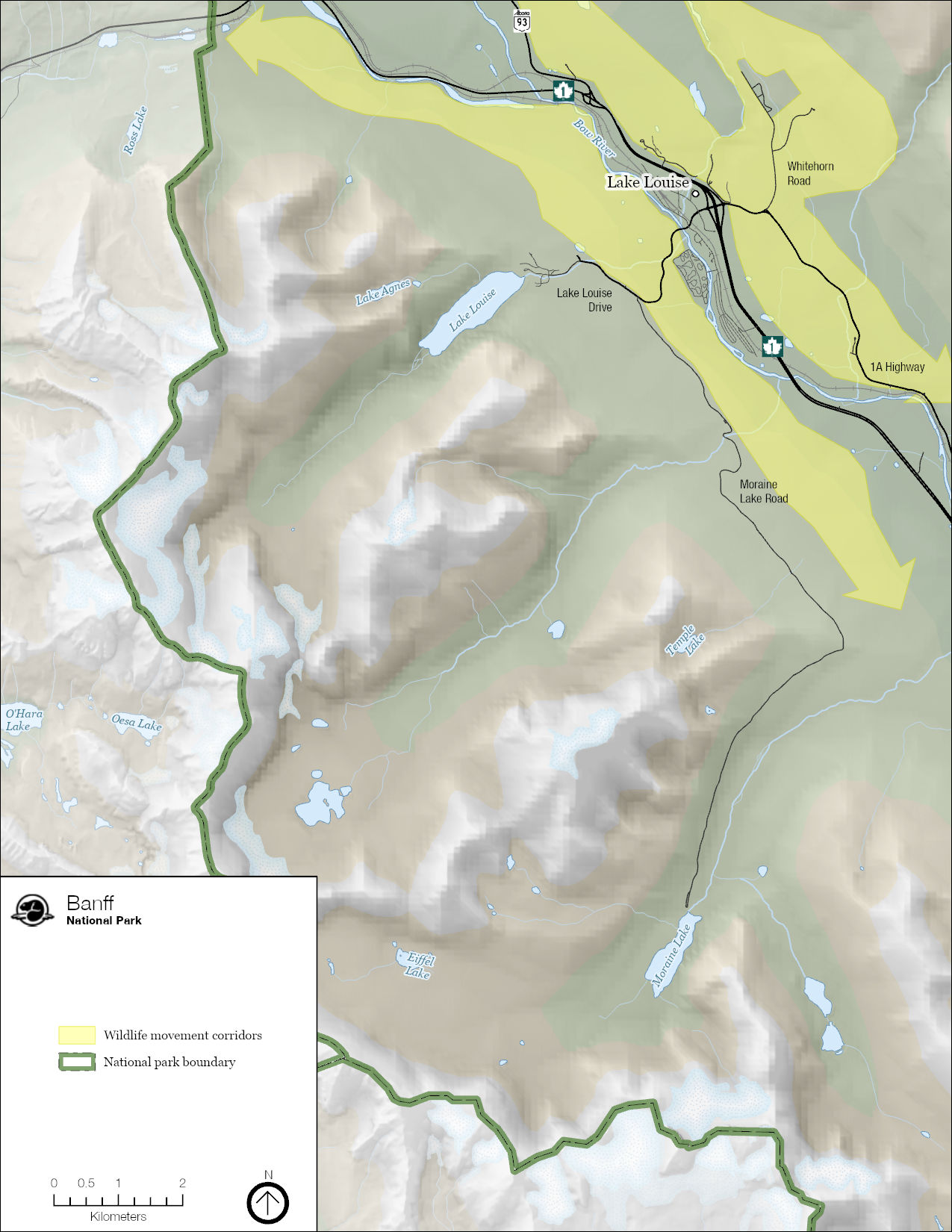
Map description
The map displays two wildlife corridors shaded in green. The Fairview wildlife corridor runs along the west side of the Bow River. It is bisected by Lake Louise Drive and encompasses the community of Lake Louise. The Whitehorn wildlife corridor runs along the east side of the Bow River. It is bisected by Whitehorn Road and encompasses a portion of the Lake Louise Ski Area.
Two wildlife corridors, Fairview and Whitehorn, pass through the Lake Louise area. These corridors provide space for large carnivores to move through the landscape, finding mates and food. Grizzly bears, wolves, and lynx are a few of the species that use these corridors.
Three ecoregions exist in the area: montane, subalpine, and alpine. Each ecoregion is home to a special set of plant and animal species including many species at risk. Non-native vegetation is concentrated along roadways, parking lots and other disturbed areas.
In addition to ecoregions, the Lake Louise area also contains aquatic ecosystems, including wetlands and riparian zones bordering the lakes, river, and streams. Riparian zones are some of the most sensitive areas and key to maintaining diverse ecosystems.
Visitor use considerations
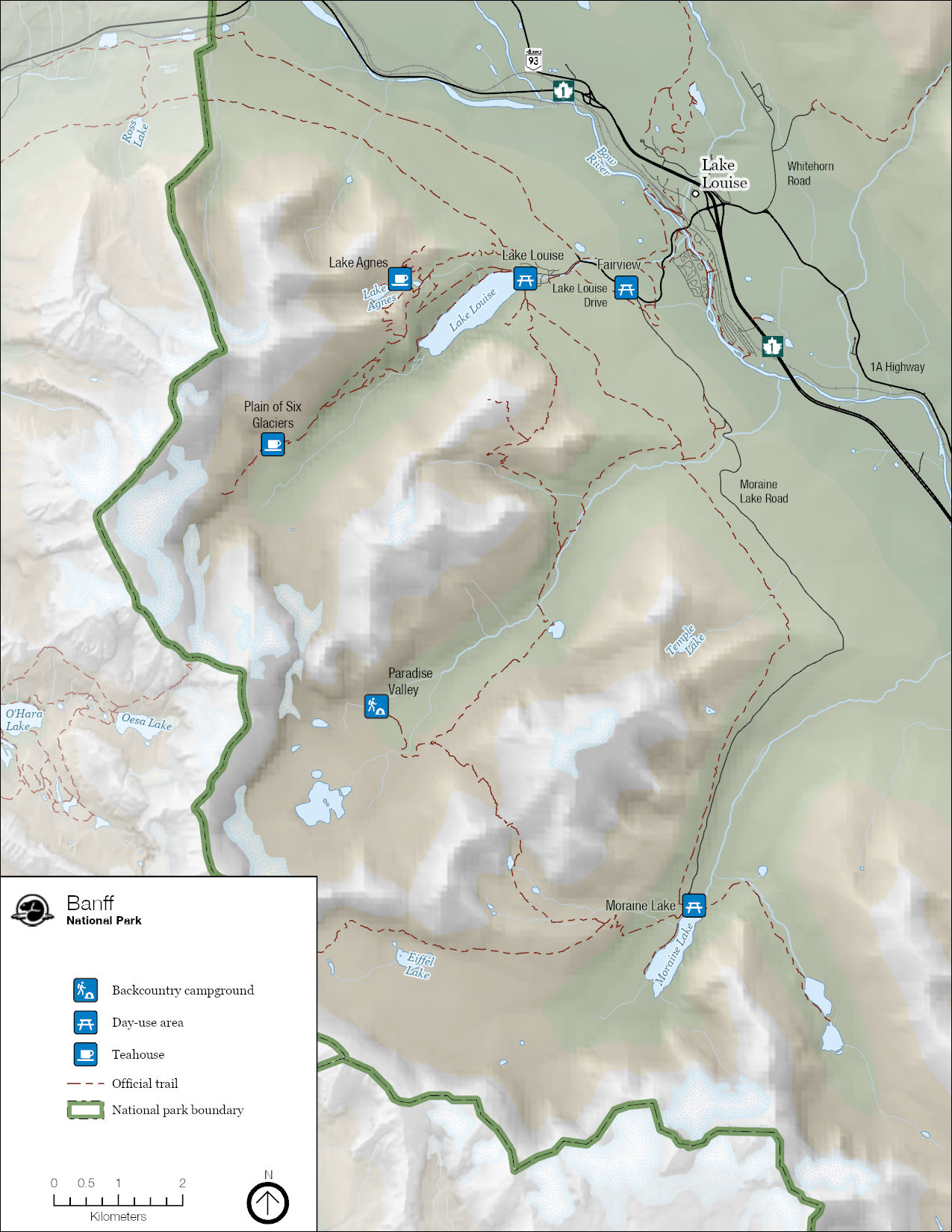
Map description
The map displays where visitor use is concentrated within the project area. Official trails, day-use areas, and roadways are displayed. Major roadways include Lake Louise Drive which connects the Trans-Canada Highway to the community of Lake Louise and Upper Lake Louise; Moraine Lake Road which connects Lake Louise Drive to Moraine Lake; and Whitehorn Road which connects the Trans-Canada Highway to the Park and Ride.
Visitor services are concentrated at Upper Lake Louise, Moraine Lake, and in the community. The lakes are accessed from dead-end roads and linked to the Lake Louise Park and Ride by the Parks Canada shuttle service.
In 2023, Lake Louise Drive saw an average of 8 785 vehicles per day during the summer. After noon, an average of 750 vehicles per hour travelled Lake Louise Drive, which is one car every 5 seconds!
In 2023, the Moraine Lake area saw approximately 5 000 visitors per day. The Upper Lake Louise area saw approximately 9 000 visitors per day, and the parking lot of over 400 stalls was by full by 8 am most mornings.
High traffic volumes may cause wary species to avoid using the area or crossing the roadway during busy periods, reducing the effectiveness of key wildlife movement corridors and potentially impacting core reproductive range for grizzly bears.
Visitor use management actions
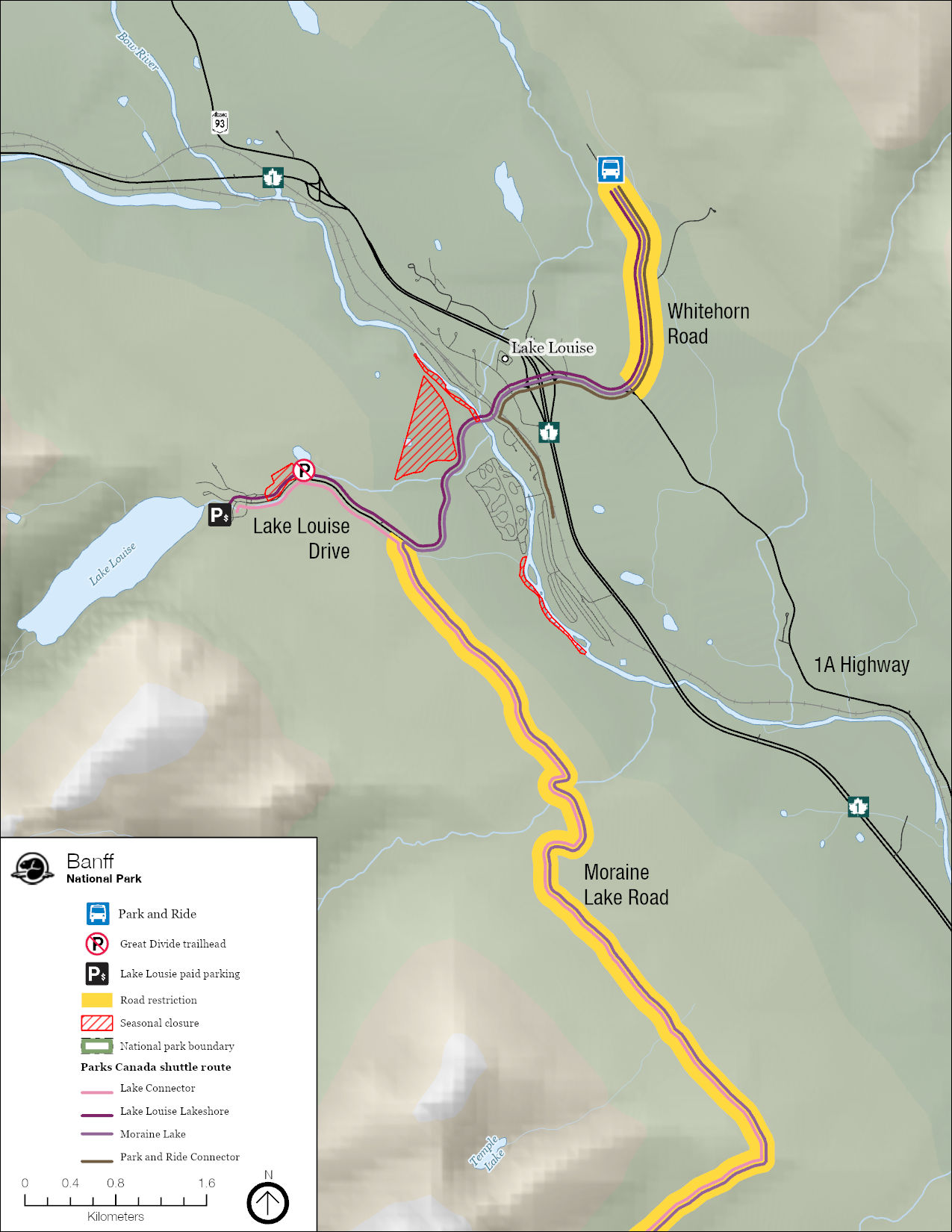
Map description
The map displays visitor use management actions currently in place. Moraine Lake Road is shown in yellow to highlight the personal vehicles restrictions in place. Whitehorn Road is also shown in yellow to highlight the overnight closure to vehicular traffic to allow for a non-disturbance period for wildlife. A paid parking symbol at Upper Lake Louise indicates that parking payments are required. Parks Canada shuttle routes are shown in purple, pink, and green and connect the Park and Ride to each lake, and well as between lakes.
Many visitor use management actions are already in place to protect ecosystems and maintain a positive visitor experience,. These include but are not limited to a Parks Canada shuttle service from a designated Park and Ride, a seasonal overnight restriction on Whitehorn Road to improve opportunities for wildlife movement, restriction of personal vehicles from Moraine Lake Road, paid parking at Upper Lake Louise, and trail and parking lot closures to reduce the footprint of disturbance in the Fairview wildlife corridor.
A complex scenario remains
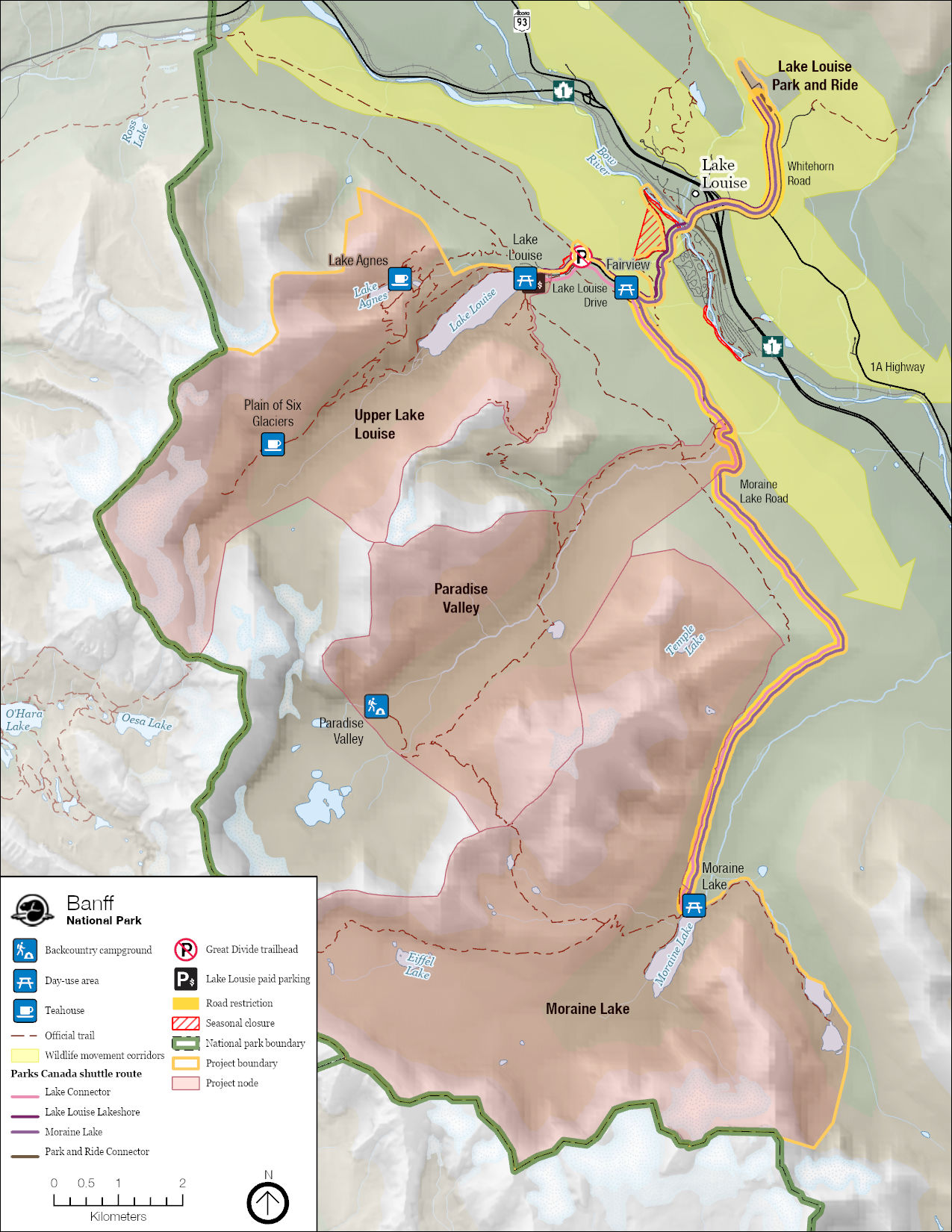
Map description
The map displays all layers from the previous three maps laid on top of each other.
Despite the many actions implemented over the years, including some that cannot be displayed on a map such as communication campaigns, there is still work to be done. Some visitors experience frustration and confusion, infrastructure in some places is stretched to capacity, and shifting visitor use patterns within the wildlife corridors may be affecting how wildlife move through the area.
Need for the Plan
What prevents you from visiting and enjoying the Lake Louise area?
The first phase of consultation on visitor use management planning for Lake Louise is now complete. This phase collected input on desired conditions and aspirations for the Lake Louise area. The next phase of consultation will focus on strategies and actions or how to achieve the desired conditions.
The next phase of consultation is anticipated to take place in spring 2025.
Managing visitor use in the Lake Louise area is complex. Many challenges have emerged in the past 10 years as Parks Canada has managed growing demand. Parks Canada has made progress on visitor use management in the Lake Louise area but key challenges remain.
Key Issues
Visitor Experience | Facilities and Operations | Natural and Cultural Resources | Staff and Visitor Safety
Visitor Experience:
Congestion due to rising visitation (31 percent over the last decade) and changing ways visitors use the area have impacted the experience of visiting Lake Louise and Moraine Lake. Access challenges, displacement of certain user groups, cleanliness of facilities, long lineups and difficulty with trip planning can make it increasingly challenging to meet the expectations of many visitors.
The area continues to see large numbers of regional day trippers who plan their visits last minute and without reservations. Sold-out shuttles, full parking lots, and roadway congestion result in disappointment and frustration for these visitors. They turn to alternate commercial options or move on to other destinations. It is estimated that between 1 800 to 2 500 private vehicles are turned away from Upper Lake Louise each day during the summer.
Commercial vehicle operators have been able to work alongside Parks Canada to increase capacity and serve visitors with special needs that are not met by Parks Canada shuttles. However, private commercial options can be significantly more expensive and are also often sold out. Parking within the vicinity of Lake Louise is extremely limited, and there are not enough parking stalls in the Lake Louise community to meet the potential demand from commercial shuttle operators. Limited space at Moraine Lake and Upper Lake Louise does not guarantee parking for commercial operators.
Facilities and Operations:
Managing the impacts of high visitor use on park operations and facilities is increasingly expensive and demanding. Operating for longer days and seasons, and in a continually busier setting stretches the park’s resources.
Roads, trails and facilities require more frequent maintenance cycles. Infrastructure was not built to handle the level of use that is currently occurring. Parks staff take longer to access busy sites to perform their regular duties. This includes maintenance and cleaning, ecological surveys, restoration, or educational programming.
Washroom facilities at key nodes require constant maintenance. In the case of Moraine Lake, human waste is pumped out at least once a week. At the teahouses in the Upper Lake Louise area, 6-10 barrels of human waste are flown out every week. All human waste ends up at the Lake Louise wastewater treatment centre which currently processes 3 500 to 4 500 cubic meters per day during peak season.
The growing traffic and shuttle program has seen significant increases in costs over the years and is not currently self-sustaining. The program budget was $9.9 million in 2023/24. Paid parking fees and shuttle fares brought in $5.22 million in revenue, leaving a $4.68 million shortfall. Revenue collected from the shuttle fees stays in Banff National Park and goes directly towards offsetting the cost of providing of providing visitor transportation services within the Lake Louise area. Fees never exceed the cost of delivering the service. They only serve to recover costs.
Natural and Cultural Resources:
The Fairview and Whitehorn corridors run through the Lake Louise area on either side of the Trans-Canada Highway. High traffic volumes can cause wary species to avoid using the area or crossing the roadway during busy periods, which would impede their movement through these key wildlife corridors.
Busy times are also increasing earlier and later into the day. High use trails such as Bow River Loop, Louise Creek, Tramline, and various unofficial trails are also within the Fairview wildlife corridor. Parks Canada has taken measures to mitigate the impacts on wildlife in these corridors. Since 2022, seasonal trail closures and restrictions have been implemented from May 15 to October 15 in the Lake Louise area, aimed at concentrating visitation in areas with high levels of human use, while allowing wildlife to move through other areas with minimal disturbances.
With an increase in visitation, there is also an increased threat of invasive and non-native species. The risk of introduction of invasive aquatic species (e.g., zebra mussels, whirling disease) increases as use levels rise. Increased off trail use in alpine areas can impact sensitive species, such as mountain goats.
Parks Canada has observed an increase in littering, feeding wildlife and entering restricted areas (e.g. fish spawning habitat located at Moraine Lake). The opportunity for learning appropriate park behaviours may be missed due to crowding and congestion.
Staff and Visitor Safety:
Traffic congestion can hinder emergency response. Congestion impedes emergency vehicles from accessing and exiting busy areas. It also makes the safe and efficient evacuation of visitors, in the case of emergency such as wildfire, more challenging.
Some visitors also arrive unprepared for outdoor experiences in the Lake Louise area. Parks Canada responded to an average of 56 incidents in the Lake Louise area from May to October (2017-2023). Incidents ranged in severity from mild to critical. Summer incidents included sprained ankles, lost hikers, cardiac arrests, heat exhaustion, falls and other incidents.
Extreme visitor frustration, especially at the Moraine Lake Road intersection prior to 2023, has led to frequent negative interactions with Parks Canada employees and, on occasion, hostile and even violent interactions between visitors and between visitors and park staff. This negatively impacts both visitor satisfaction and the morale of employees.
Visitor use data
Amount of visitor use
Daily snapshot
- The Upper Lake Louise area saw approximately 9 000 daily visitors during the 2023 operating season. However, accuracy of commercial use at Upper Lake Louise is limited to observations and estimates, so this number could vary.
- The Moraine Lake area saw approximately 5 000 daily visitors during the 2023 operational season. This number is based on recorded averages throughout the season. It can fluctuate depending on the level of commercial use on any given day.
- In 2023, we estimate that the Parks Canada shuttle transported 24% of all visitors to Upper Lake Louise, and 51% of all visitors to Moraine Lake. 87% of shuttle riders visited both lakes in the same day.
.jpg)
Estimated Daily Visitation at Upper Lake Louise by Mode of Travel (2023 Operational Season) - text version
| Mode of transport | Average # of visitors per day | % of total |
|---|---|---|
| Parks Canada shuttle | 2122 | 45% |
| Commercial bus | 1120 | 24% |
| Roam Public Transit | 735 | 15% |
| Personal vehicle | 3444 | 72% |
| Active transport | 225 | 5% |
| Hotel guests | 1095 | 23% |
.jpg)
Estimated Daily Visitation at Moraine Lake by Mode of Travel (2023 Operational Season) - text version
| Mode of transport | Average # of visitors per day | % of total |
|---|---|---|
| Parks Canada shuttle | 2600 | 1% |
| Commercial bus | 2100 | 41% |
| Roam Public Transit | 254 | 51% |
| Personal vehicle | 40 | 5% |
| Active transport | 33 | 1% |
| Hotel guests | 78 | 2% |
Level of use over the years
Visitation at Moraine Lake and Lake Louise has changed over the past ten years as various traffic management tools have been implemented. The introduction of the Parks Canada shuttle increased the number of visitors at these sites. However, as the shuttle system was expanded, further efforts were made to reduce the use of personal vehicles and shift towards a mass transit system. The graph below shows estimated visitation by mode of transport from 2009 to 2023 at Moraine Lake.

Daily Estimated Moraine Lake Visitation over the Years, by Mode of Transit - text version
| 2009 | 2010 | 2014 | 2017 | 2018 | 2019 | 2020 | 2021 | 2022 | 2023 | |
|---|---|---|---|---|---|---|---|---|---|---|
| Personal vehicles | 2976 | 2896 | 3584 | 4312 | 3401 | 3555 | 3113 | 2988 | 3145 | 118 |
| Parks Canada shuttles | 0 | 0 | 511 | 877 | 755 | 866 | 365 | 686 | 1490 | 2600 |
| Commercial buses | 845 | 975 | 1053 | 1287 | 1300 | 1300 | 13 | 13 | 689 | 2100 |
| Roam Public Transit | 0 | 0 | 0 | 0 | 0 | 55 | 68 | 56 | 157 | 253 |
| All modes of transit | 3821 | 3871 | 5148 | 6476 | 5456 | 5776 | 3559 | 3743 | 5481 | 5071 |
Traffic volumes on Moraine Lake Road peaked in 2017. During that year, the parking lot was overflowing, and vehicles parked for several kilometres down the roadway. Since then, traffic volumes have declined 80% and the number of visitors using mass transit has increased.

Annual Traffic Volumes along Moraine Lake Road (June to September. Counter 2.1km east of Lake Louise Drive) - text version
| 2001 | 2002 | 2003 | 2004 | 2005 | 2006 | 2007 | 2008 | 2009 | 2010 | 2011-2013 | 2014 | 2015 | 2016 | 2017 | 2018 | 2019 | 2020 | 2021 | 2022 | 2023 | |
|---|---|---|---|---|---|---|---|---|---|---|---|---|---|---|---|---|---|---|---|---|---|
| Two way traffic volumes | 242,982 | 243,083 | 234,131 | 244,041 | 241,434 | 242,923 | 258,619 | 248,290 | 245,412 | 241,804 | No data | 302,412 | No data | 359,945 | 396,481 | 311,681 | 324,713 | 242,529 | 253,248 | 195,595 | 81,177 |
Due to data constraints, estimating the number of visitors over the years for Upper Lake Louise is complex. However, we can still look at traffic volumes, shuttle ridership, parking permits and trail use to infer visitation levels.
The graph below shows annual two-way traffic volumes along Lake Louise Drive from 2001 to 2023. Traffic volumes spiked in 2019 and have since seen a 17% decrease.

Annual Traffic Volumes along Lake Louise Drive (January to December. Counter 2.2km south from TCH) - text version
| 2001 | 2002 | 2003 | 2004 | 2005 | 2006 | 2007 | 2008 | 2009 | 2010 | 2011 | 2012 | 2013 | 2014 | 2015 | 2016 | 2017 | 2018 | 2019 | 2020 | 2021 | 2022 | 2023 | |
|---|---|---|---|---|---|---|---|---|---|---|---|---|---|---|---|---|---|---|---|---|---|---|---|
| Two way traffic volumes | 1,423,068 | 1,341,850 | 1,281,676 | 1,308,298 | 1,298,712 | 1,315,475 | 1,332,416 | 1,249,326 | 1,214,759 | 1,217,721 | 1,236,934 | 1,309,458 | 1,330,746 | 1,421,190 | 1,610,759 | 1,794,183 | 2,021,921 | 2,062,692 | 2,071,838 | 1,348,444 | 1,399,480 | 1,824,200 | 1,729,639 |
The graph below shows average daily shuttle ridership to Lake Louise and Moraine Lake from 2013 to 2023. Daily ridership has increased significantly over the past 3 years.
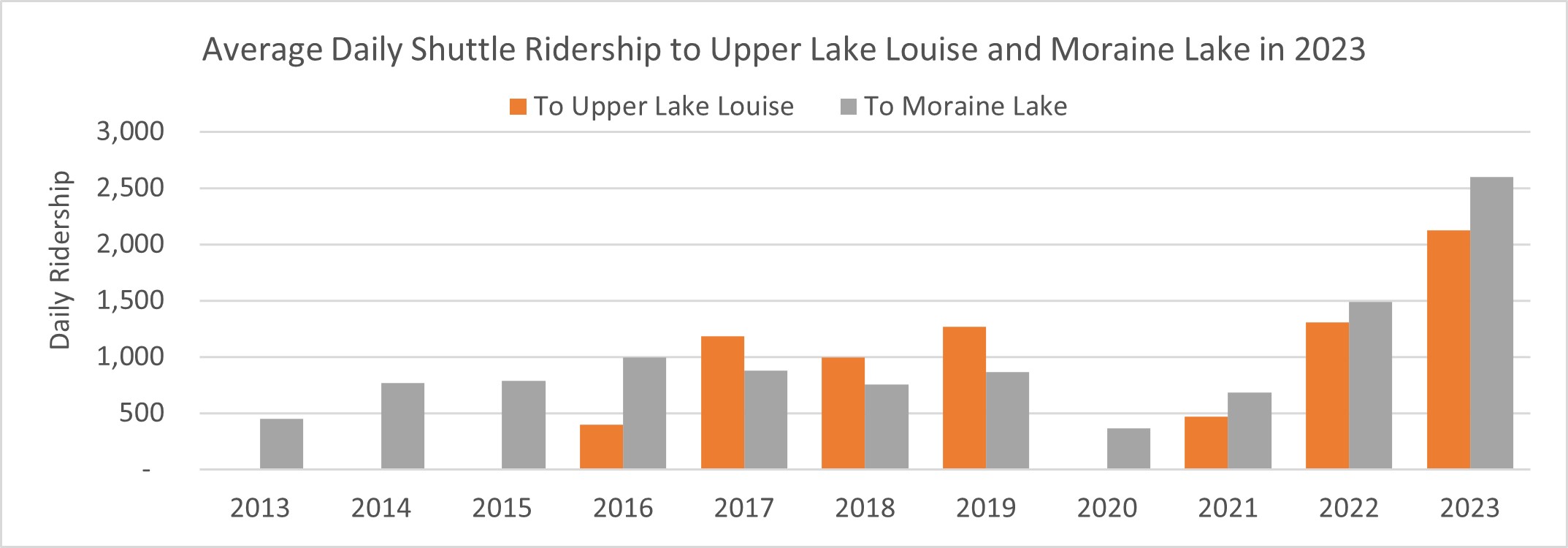
Average Daily Shuttle Ridership to Upper Lake Louise and Moraine Lake in 2023 - text version
| 2013 | 2014 | 2015 | 2016 | 2017 | 2018 | 2019 | 2020 | 2021 | 2022 | 2023 | |
|---|---|---|---|---|---|---|---|---|---|---|---|
| To Upper Lake Louise | - | - | - | 400 | 1,182 | 992 | 1,265 | - | 469 | 1,303 | 2,122 |
| To Moraine Lake | 447 | 767 | 789 | 994 | 877 | 755 | 866 | 365 | 686 | 1,490 | 2,600 |
Using active transportation (e.g. hiking, biking) to access Lake Louise and Moraine Lake has increased over the years. Trail use around Lake Louise Drive (which is bisected by the Fairview wildlife corridor) saw a substantial increase in 2023.
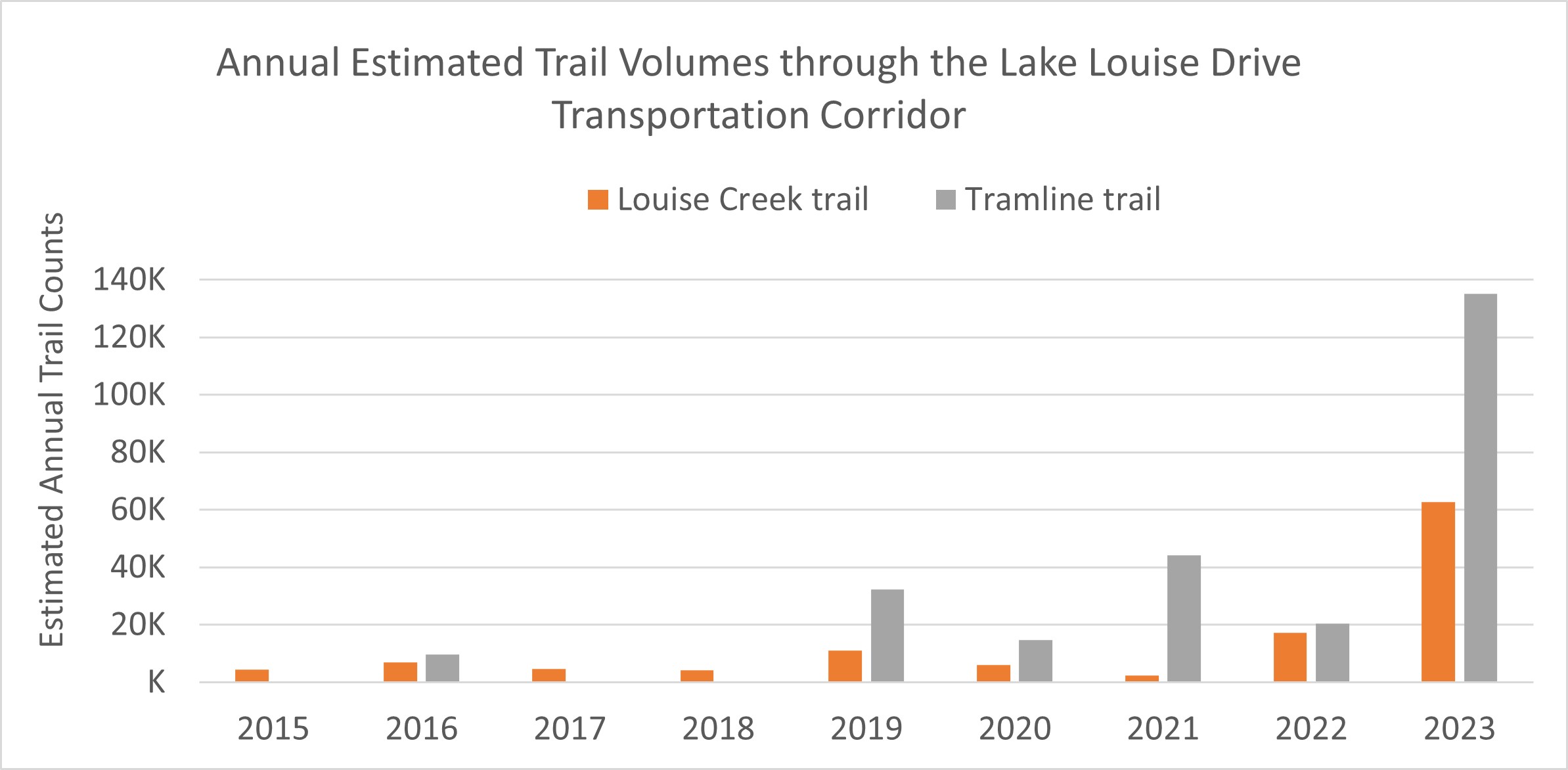
Annual Estimated Trail Volumes through the Lake Louise Drive Transportation Corridor - text version
Note: Tramline Trail counter is missing data for 2015, 2017 and 2018.
| 2015 | 2016 | 2017 | 2018 | 2019 | 2020 | 2021 | 2022 | 2023 | |
|---|---|---|---|---|---|---|---|---|---|
| Louise Creek trail | 4,498 | 6,903 | 4,652 | 4,205 | 11,017 | 6,017 | 2,379 | 17,310 | 62,770 |
| Tramline trail | - | 9,765 | - | - | 32,219 | 14,765 | 44,141 | 20,383 | 135,161 |
Timing of use
Throughout the year
Visitation in the Lake Louise area mirrors trends for Banff National Park as a whole. Visitation peaks during July and August. The shoulder season (April, May, and October) has become busier over the past 10 years. The exception is the Larch Valley Trail in the Moraine Lake area which sees peak use during the fall larch season.

Banff National Park Average Monthly Visitation, 2013-2022 compared to 2023 - text version
| 2013 | 2014 | 2015 | 2016 | 2017 | 2018 | 2019 | 2020 | 2021 | 2022 | Average 2013-2022 | 2023 | |
|---|---|---|---|---|---|---|---|---|---|---|---|---|
| January | 165,053 | 170,989 | 184,908 | 196,594 | 201,728 | 203,653 | 208,102 | 199,069 | 207,272 | 210,293 | 194,766 | 212,800 |
| February | 159,943 | 164,645 | 188,618 | 212,236 | 201,596 | 186,355 | 177,911 | 210,041 | 190,117 | 216,405 | 190,787 | 205,379 |
| March | 198,479 | 184,119 | 203,779 | 239,106 | 228,398 | 229,060 | 236,808 | 155,230 | 239,551 | 239,529 | 215,406 | 237,440 |
| April | 193,102 | 231,318 | 246,723 | 242,624 | 267,780 | 250,481 | 262,067 | - | 246,884 | 278,486 | 221,946 | 283,215 |
| May | 253,100 | 258,265 | 296,369 | 300,463 | 319,958 | 319,266 | 317,797 | - | 225,915 | 321,116 | 261,225 | 327,200 |
| June | 211,404 | 300,022 | 325,953 | 349,514 | 370,563 | 370,162 | 389,145 | 271,296 | 298,464 | 361,655 | 324,818 | 393,564 |
| July | 512,139 | 560,860 | 630,456 | 680,360 | 688,295 | 681,753 | 688,544 | 581,202 | 653,888 | 694,127 | 637,162 | 718,191 |
| August | 603,812 | 633,025 | 631,288 | 659,540 | 674,789 | 642,871 | 723,828 | 638,928 | 647,908 | 685,408 | 654,139 | 696,030 |
| September | 388,979 | 397,853 | 433,022 | 475,233 | 491,712 | 452,706 | 472,335 | 465,503 | 504,913 | 534,378 | 461,663 | 534,099 |
| October | 129,081 | 140,611 | 145,819 | 141,951 | 154,252 | 144,185 | 149,681 | 147,043 | 157,134 | 164,404 | 147,416 | 164,677 |
| November | 101,375 | 103,512 | 116,665 | 131,456 | 123,190 | 125,268 | 126,018 | 124,894 | 125,101 | 117,864 | 119,534 | 130,184 |
| December | 125,262 | 141,692 | 148,117 | 146,365 | 148,136 | 153,390 | 151,422 | 135,719 | 140,679 | 143,765 | 143,455 | 163,303 |
After the relocation of the Lake Louise Park and Ride to the Lake Louise Ski Area, there was a shift in traffic patterns on Whitehorn Road. Peak use on this road is now during July and August, similar to peak ski season in January through March.
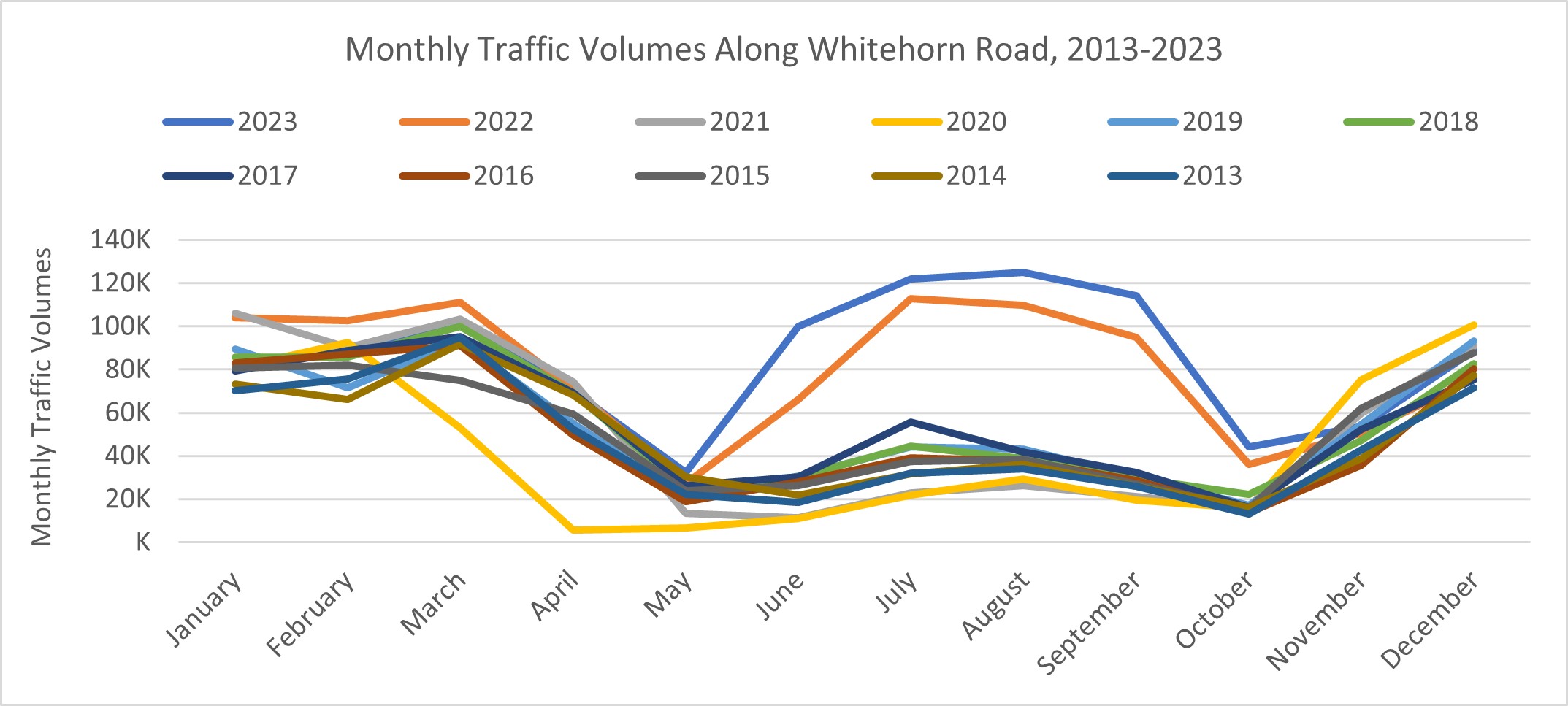
Monthly Traffic Volumes Along Whitehorn Road, 2013-2023 - text version
| January | February | March | April | May | June | July | August | September | October | November | December | |
|---|---|---|---|---|---|---|---|---|---|---|---|---|
| 2023 | 81,073 | 88,195 | 101,742 | 69,998 | 32,203 | 99,895 | 121,934 | 124,909 | 114,000 | 44,036 | 53,470 | 88,911 |
| 2022 | 103,934 | 102,604 | 111,209 | 70,835 | 27,351 | 66,178 | 112,634 | 109,667 | 94,772 | 36,107 | 50,429 | 75,727 |
| 2021 | 105,979 | 90,028 | 103,241 | 74,115 | 13,504 | 11,213 | 22,841 | 26,094 | 21,001 | 15,840 | 59,787 | 90,781 |
| 2020 | 80,522 | 92,617 | 52,834 | 5,552 | 6,619 | 11,192 | 21,714 | 29,196 | 19,429 | 15,669 | 75,136 | 100,719 |
| 2019 | 89,429 | 71,524 | 93,259 | 54,891 | 21,331 | 30,471 | 44,260 | 42,986 | 30,164 | 17,247 | 54,476 | 93,020 |
| 2018 | 85,672 | 85,677 | 99,947 | 69,057 | 24,513 | 30,141 | 44,563 | 38,842 | 29,638 | 22,162 | 47,124 | 82,636 |
| 2017 | 79,170 | 88,662 | 95,060 | 69,290 | 26,075 | 30,323 | 55,785 | 41,796 | 32,206 | 16,222 | 52,202 | 75,148 |
| 2016 | 83,057 | 86,940 | 91,089 | 49,630 | 18,763 | 27,896 | 39,034 | 37,823 | 28,767 | 13,836 | 35,593 | 80,368 |
| 2015 | 80,809 | 81,887 | 74,918 | 59,359 | 23,850 | 26,315 | 37,472 | 38,277 | 26,835 | 15,727 | 62,061 | 87,641 |
| 2014 | 73,375 | 66,256 | 91,704 | 68,003 | 30,201 | 21,975 | 31,814 | 36,096 | 25,849 | 16,110 | 38,606 | 77,345 |
| 2013 | 70,300 | 75,579 | 94,853 | 52,126 | 22,112 | 18,586 | 31,892 | 34,124 | 25,891 | 13,139 | 42,676 | 71,544 |
Throughout the day
The amount of time visitors spend at Moraine Lake and Lake Louise is highly variable. Visitors stay anywhere from 30 minutes to over 16 hours depending on their activity. Parks Canada estimates that the average length of stay is 2.5 hours at Upper Lake Louise, and 1.5 hours at Moraine Lake.
Traffic volumes can help determine the busiest times of visitation throughout the day. In 2023, visitor use began in the Upper Lake Louise area around 6 am and lasted until 9 pm (May to October). Peak use occurs around 1 pm to 3 pm. During July and August, peak visitation extends even further into the dawn and dusk hours.

Traffic Volumes Along Lake Louise Drive Throughout the Day, Summer 2023 - text version
| Two way traffic | Southbound traffic (towards Upper Lake Louise) | Northbound traffic (towards community) | |
|---|---|---|---|
| 1 AM | 11 | 5 | 6 |
| 2 AM | 5 | 3 | 2 |
| 3 AM | 4 | 2 | 1 |
| 4 AM | 6 | 4 | 2 |
| 5 AM | 23 | 18 | 5 |
| 6 AM | 80 | 70 | 10 |
| 7 AM | 195 | 166 | 29 |
| 8 AM | 259 | 183 | 76 |
| 9 AM | 369 | 219 | 150 |
| 10 AM | 464 | 249 | 215 |
| 11 AM | 556 | 289 | 267 |
| 12 PM | 634 | 325 | 309 |
| 1 PM | 681 | 339 | 341 |
| 2 PM | 688 | 345 | 343 |
| 3 PM | 697 | 338 | 359 |
| 4 PM | 686 | 324 | 362 |
| 5 PM | 667 | 301 | 366 |
| 6 PM | 600 | 255 | 345 |
| 7 PM | 506 | 209 | 296 |
| 8 PM | 390 | 164 | 226 |
| 9 PM | 261 | 98 | 163 |
| 10 PM | 136 | 51 | 85 |
| 11 PM | 63 | 27 | 36 |
| 12 AM | 28 | 12 | 16 |
During the 2023 shuttle season, visitor use began at the Lake Louise Park and Ride between 6 am and 7 am and declined after 8pm. This aligned with the seasonal overnight restrictions along Whitehorn Road. Mornings are the most popular times for shuttle departures so incoming traffic began to decrease around 2 pm.
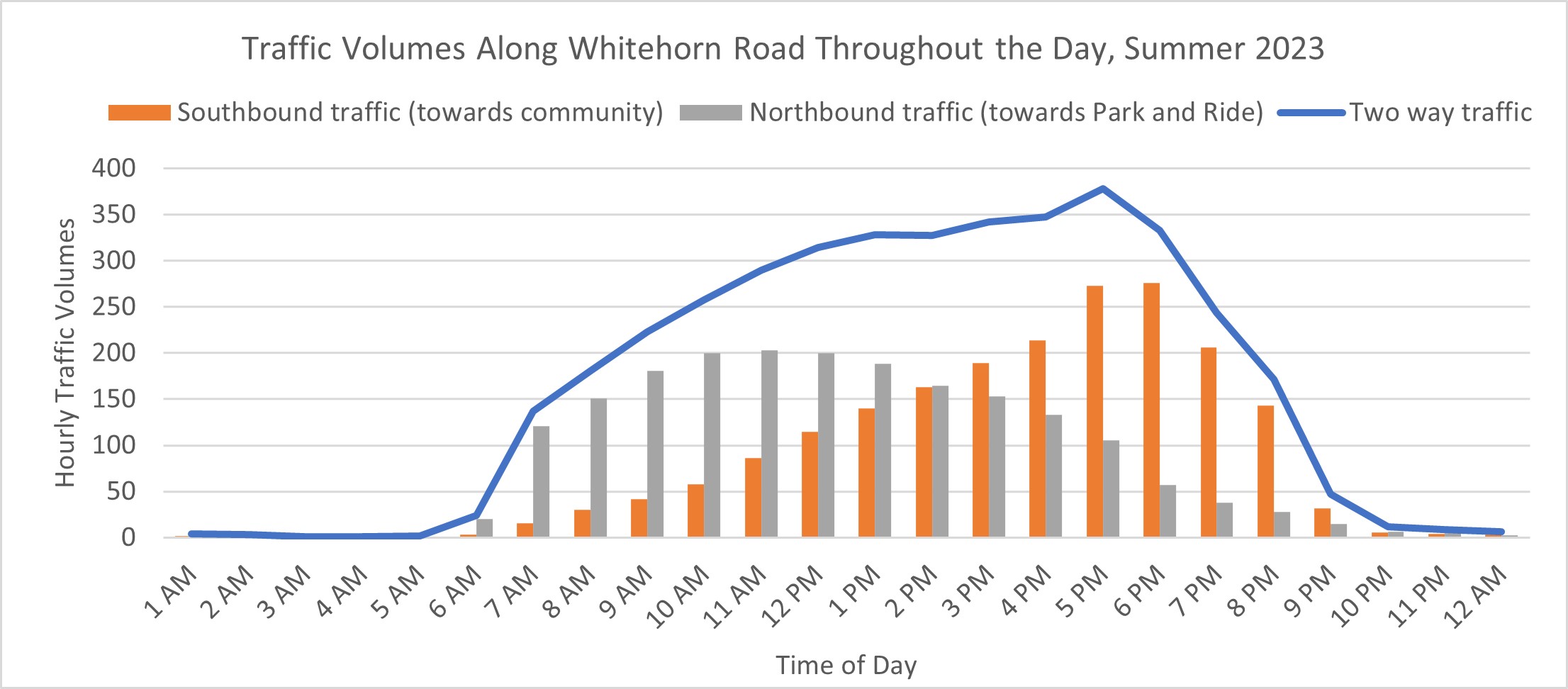
Traffic Volumes Along Whitehorn Road Throughout the Day, Summer 2023 - text version
| Two way traffic | Southbound traffic (towards community) | Northbound traffic (towards Park and Ride) | |
|---|---|---|---|
| 1 AM | 4 | 2 | 2 |
| 2 AM | 4 | 2 | 2 |
| 3 AM | 1 | 0 | 1 |
| 4 AM | 1 | 1 | 1 |
| 5 AM | 1 | 1 | 1 |
| 6 AM | 24 | 3 | 21 |
| 7 AM | 137 | 16 | 121 |
| 8 AM | 181 | 30 | 151 |
| 9 AM | 223 | 42 | 181 |
| 10 AM | 258 | 57 | 200 |
| 11 AM | 289 | 87 | 203 |
| 12 PM | 315 | 115 | 200 |
| 1 PM | 328 | 140 | 188 |
| 2 PM | 327 | 163 | 164 |
| 3 PM | 342 | 189 | 153 |
| 4 PM | 347 | 214 | 133 |
| 5 PM | 378 | 273 | 105 |
| 6 PM | 333 | 276 | 57 |
| 7 PM | 244 | 206 | 38 |
| 8 PM | 171 | 143 | 28 |
| 9 PM | 47 | 32 | 15 |
| 10 PM | 12 | 6 | 6 |
| 11 PM | 9 | 4 | 5 |
| 12 AM | 6 | 3 | 3 |
During the 2023 shuttle season, visitor use began in the Moraine Lake area around 5 am and lasted until 9 pm. Parks Canada shuttles began operating at 6:30 am and the last return shuttle was at 8 pm.
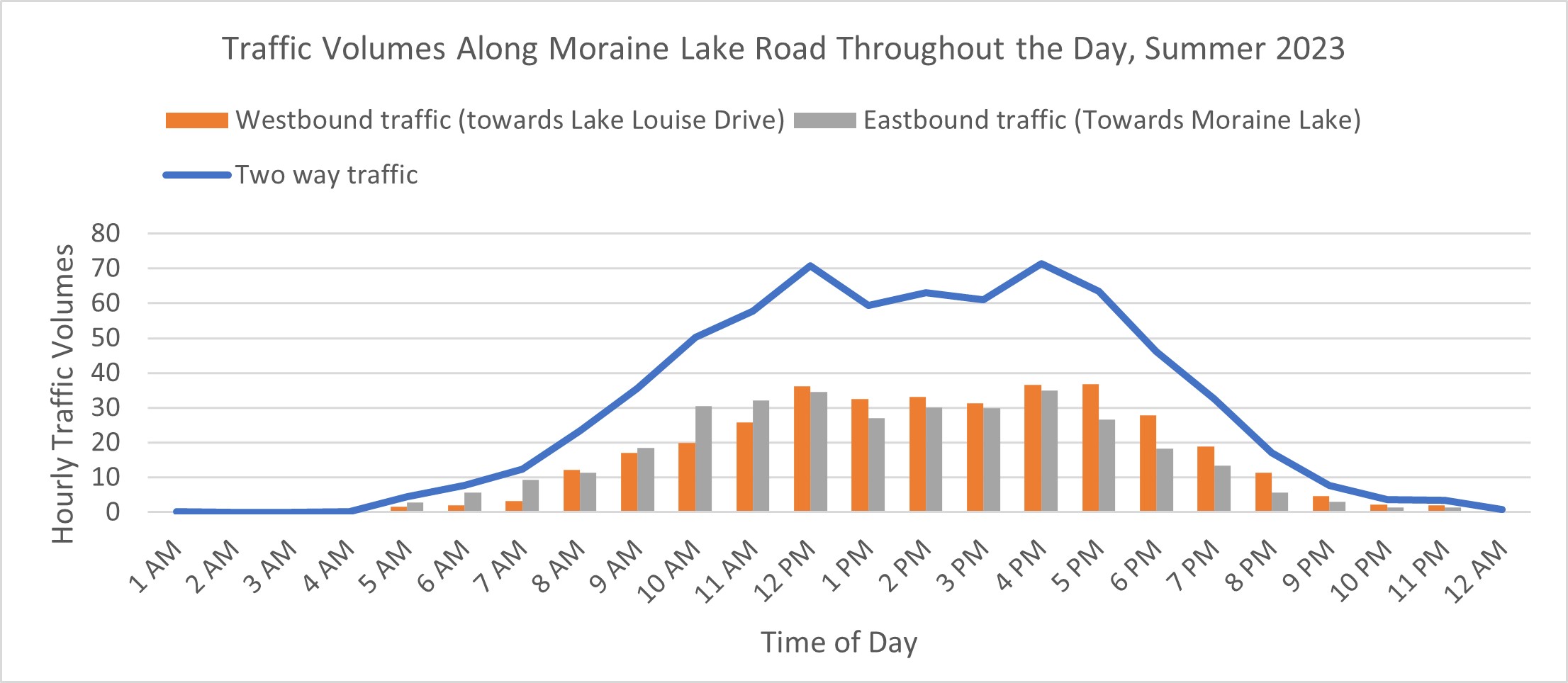
Traffic Volumes Along Moraine Lake Road Throughout the Day, Summer 2023 - text version
| Two way traffic | Westbound traffic (towards Lake Louise Drive) | Eastbound traffic (Towards Moraine Lake) | |
|---|---|---|---|
| 1 AM | 0 | 0 | 0 |
| 2 AM | 0 | 0 | 0 |
| 3 AM | 0 | 0 | 0 |
| 4 AM | 0 | 0 | 0 |
| 5 AM | 4 | 2 | 3 |
| 6 AM | 8 | 2 | 6 |
| 7 AM | 12 | 3 | 9 |
| 8 AM | 23 | 12 | 11 |
| 9 AM | 36 | 17 | 18 |
| 10 AM | 50 | 20 | 30 |
| 11 AM | 58 | 26 | 32 |
| 12 PM | 71 | 36 | 34 |
| 1 PM | 59 | 33 | 27 |
| 2 PM | 63 | 33 | 30 |
| 3 PM | 61 | 31 | 30 |
| 4 PM | 71 | 36 | 35 |
| 5 PM | 63 | 37 | 27 |
| 6 PM | 46 | 28 | 18 |
| 7 PM | 32 | 19 | 13 |
| 8 PM | 17 | 11 | 6 |
| 9 PM | 8 | 5 | 3 |
| 10 PM | 4 | 2 | 1 |
| 11 PM | 3 | 2 | 1 |
| 12 AM | 1 | 0 | 0 |
Over the years
Timing of visitation has shifted earlier in the day over the years, shown in traffic volumes and trail counter data. In certain places, such as Whitehorn Road, Parks Canada manages the timing of use with overnight restrictions to ensure a quiet period for wildlife. The shift in visitation to the dawn and pre-dawn hours at Moraine Lake was one of the reasons why personal vehicles were restricted on Moraine Lake Road in 2023.
The graph below displays estimated vehicle accumulation throughout the day, year over year, in the Upper Lake Louise area. Traffic volumes in the Upper Lake Louise area have shifted earlier in the day as the years have gone on. The parking lot is filling earlier than in prior years.

Estimated Vehicle Accumulation West of Great Divide Lot, Summer Average Year over Year - text version
| 1 AM | 2 AM | 3 AM | 4 AM | 5 AM | 6 AM | 7 AM | 8 AM | 9 AM | 10 AM | 11 AM | 12 PM | 1 PM | 2 PM | 3 PM | 4 PM | 5 PM | 6 PM | 7 PM | 8 PM | 9 PM | 10 PM | 11 PM | 12 AM | |
|---|---|---|---|---|---|---|---|---|---|---|---|---|---|---|---|---|---|---|---|---|---|---|---|---|
| 2023 | 0 | 1 | 2 | 4 | 17 | 87 | 223 | 329 | 381 | 384 | 382 | 374 | 370 | 368 | 354 | 328 | 291 | 230 | 168 | 117 | 50 | 4 | -10 | -15 |
| 2022 | -2 | -2 | 0 | 6 | 44 | 127 | 221 | 334 | 386 | 400 | 403 | 401 | 407 | 408 | 383 | 362 | 329 | 273 | 199 | 123 | 55 | 8 | -1 | -7 |
| 2020 | 1 | 1 | 2 | 3 | 4 | 10 | 57 | 160 | 298 | 387 | 426 | 431 | 423 | 404 | 388 | 355 | 293 | 197 | 113 | 49 | 13 | -3 | -3 | -3 |
| 2019 | 0 | 0 | 0 | 2 | 6 | 44 | 214 | 399 | 479 | 494 | 498 | 496 | 486 | 481 | 466 | 433 | 386 | 314 | 224 | 122 | 50 | 15 | -3 | -11 |
| 2018 | -1 | -1 | 0 | 0 | 1 | 16 | 96 | 280 | 480 | 532 | 547 | 551 | 557 | 564 | 543 | 509 | 451 | 356 | 240 | 123 | 47 | 14 | -2 | -8 |
| 2017 | 0 | 0 | 0 | 2 | 3 | 20 | 53 | 156 | 377 | 539 | 560 | 568 | 573 | 570 | 550 | 506 | 443 | 325 | 212 | 125 | 59 | 16 | -3 | -8 |
| 2009 | 0 | 1 | 2 | 2 | 2 | 5 | 5 | 14 | 39 | 106 | 210 | 311 | 377 | 414 | 434 | 414 | 349 | 261 | 170 | 103 | 73 | 66 | 66 | 64 |
| 2001 | 2 | 0 | 0 | 0 | 1 | 4 | 14 | 38 | 94 | 171 | 283 | 410 | 484 | 499 | 490 | 439 | 341 | 227 | 128 | 64 | 29 | 4 | -4 | -7 |
| # Parking stalls at ULL post-2022 | 420 | 420 | 420 | 420 | 420 | 420 | 420 | 420 | 420 | 420 | 420 | 420 | 420 | 420 | 420 | 420 | 420 | 420 | 420 | 420 | 420 | 420 | 420 | 420 |
The graph below displays estimated vehicle accumulation throughout the day, year over year, in the Moraine Lake area. Traffic volumes in the Moraine Lake area have shifted earlier in the day over the years. In summer 2022, the parking lot was filling between 4 am and 5 am. In 2023, the Moraine Lake parking lot operated at or below capacity. There was minimal congestion due to the restriction of personal vehicles and the move towards mass transit.
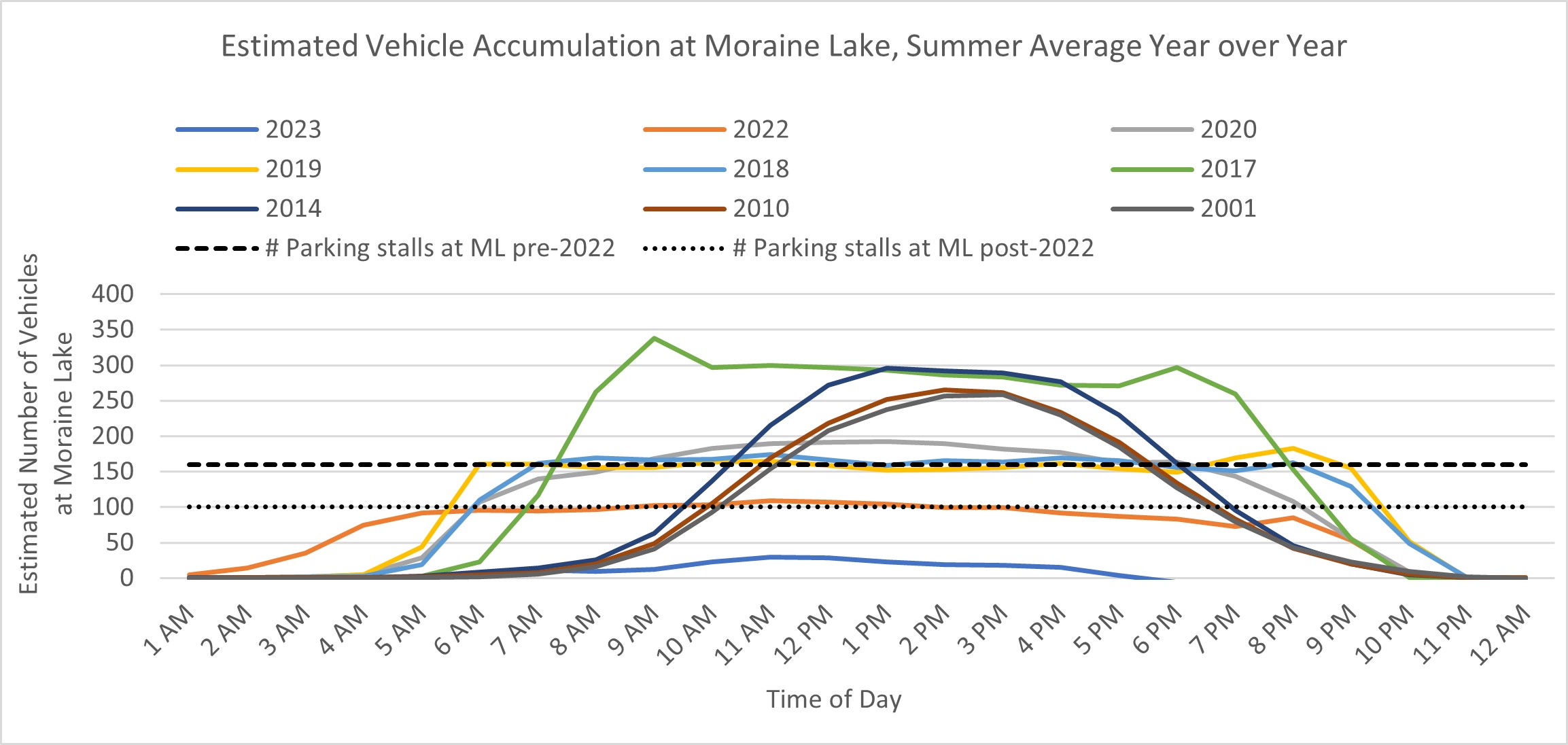
Estimated Vehicle Accumulation at Moraine Lake, Summer Average Year over Year - text version
| 1 AM | 2 AM | 3 AM | 4 AM | 5 AM | 6 AM | 7 AM | 8 AM | 9 AM | 10 AM | 11 AM | 12 PM | 1 PM | 2 PM | 3 PM | 4 PM | 5 PM | 6 PM | 7 PM | 8 PM | 9 PM | 10 PM | 11 PM | 12 AM | |
|---|---|---|---|---|---|---|---|---|---|---|---|---|---|---|---|---|---|---|---|---|---|---|---|---|
| 2023 | 0 | 0 | 0 | 0 | 2 | 6 | 11 | 9 | 12 | 23 | 30 | 29 | 22 | 19 | 18 | 15 | 4 | -6 | -12 | -17 | -19 | -20 | -21 | -21 |
| 2022 | 4 | 14 | 35 | 74 | 91 | 95 | 94 | 97 | 102 | 103 | 109 | 107 | 104 | 99 | 99 | 92 | 87 | 83 | 73 | 85 | 53 | 4 | 1 | 1 |
| 2020 | 1 | 1 | 1 | 5 | 28 | 107 | 140 | 149 | 168 | 183 | 189 | 192 | 193 | 189 | 182 | 177 | 163 | 164 | 143 | 108 | 55 | 8 | -7 | -7 |
| 2019 | 1 | 1 | 2 | 5 | 44 | 161 | 160 | 155 | 156 | 163 | 165 | 159 | 152 | 153 | 156 | 161 | 154 | 150 | 169 | 183 | 154 | 52 | 0 | 1 |
| 2018 | 1 | 1 | 2 | 3 | 19 | 110 | 162 | 169 | 166 | 168 | 174 | 166 | 159 | 166 | 163 | 169 | 165 | 156 | 151 | 163 | 129 | 48 | 1 | 0 |
| 2017 | 0 | -1 | -1 | 0 | 2 | 22 | 116 | 262 | 338 | 296 | 300 | 297 | 292 | 286 | 284 | 272 | 271 | 297 | 259 | 153 | 55 | 0 | -6 | -6 |
| 2014 | 0 | 0 | 0 | 1 | 2 | 9 | 14 | 25 | 63 | 137 | 215 | 272 | 296 | 292 | 289 | 276 | 229 | 162 | 96 | 46 | 20 | 4 | 0 | 0 |
| 2010 | 0 | 0 | 1 | 1 | 2 | 5 | 8 | 20 | 48 | 105 | 169 | 218 | 251 | 265 | 261 | 234 | 191 | 134 | 83 | 42 | 20 | 6 | 1 | 0 |
| 2001 | 0 | 0 | 0 | 0 | 1 | 2 | 6 | 16 | 41 | 92 | 154 | 208 | 238 | 257 | 258 | 230 | 185 | 127 | 80 | 43 | 23 | 9 | 2 | 0 |
| # Parking stalls at ML pre-2022 | 160 | 160 | 160 | 160 | 160 | 160 | 160 | 160 | 160 | 160 | 160 | 160 | 160 | 160 | 160 | 160 | 160 | 160 | 160 | 160 | 160 | 160 | 160 | 160 |
| # Parking stalls at ML post-2022 | 100 | 100 | 100 | 100 | 100 | 100 | 100 | 100 | 100 | 100 | 100 | 100 | 100 | 100 | 100 | 100 | 100 | 100 | 100 | 100 | 100 | 100 | 100 | 100 |
Type of use
Recreation opportunities
Most people visit over the course of a single day. Multi-day trips though still make up a sizable portion of visitors in the Lake Louise area. These multi-day visitors include both frontcountry (residents, hotels, campground) and backcountry (Paradise Valley campground, Neil Colgan ACC Hut, or bivouacs).
Visitors come to the area to participate in many recreational activities between May and October. These include sightseeing, hiking, mountaineering, rock climbing, trail running, paddling, and cycling. Many commercial opportunities also exist. These include boat rentals, guided hikes and climbs, horse tours, and photography tours.
Age and group size
Although only a portion of visitors take the Parks Canada shuttle, it offers a representative snapshots of visitor ages and party size in the Lake Louise area. Shuttle reservations in 2023 consisted of 80 percent adults, 10 percent youth, 6 percent seniors and 4 percent children. The average number of people per group was three.
Origin
Lake Louise remains a popular place with regional travellers, as well as international visitors. Parks Canada shuttle data is one of the best sources of visitor origin data for Lake Louise. Approximately 50 percent of shuttle riders in 2023 were from Canada, with two thirds of those from Alberta, British Columbia, or Saskatchewan. Data from Banff & Lake Louise Tourism indicates that 60 percent of visitors to Banff National Park in 2023 were from Alberta, British Columbia, or Saskatchewan.
Back to top
Draft desired conditions
Desired condition statements describe how the Lake Louise area will look, feel, sound, and function in an ideal future. They focus on what the area should be like and not how to achieve the vision. These desired conditions will be updated using public feedback and shared during the next phase of engagement in 2025. Visit letstalkmountainparks.ca to read what we heard.
What We Heard: Lake Louise Area Visitor Use Management — Phase 1: Validating Draft Desired Conditions New
Executive Summary
Visitor Experience | Facilities and Operations | Natural and Cultural Resources | Staff and Visitor Safety
Visitor Experience:
| Desired condition | Where does this apply? |
|---|---|
| Traffic congestion on roadways and within parking areas is minimal and traffic flow remains efficient. | Throughout the project area |
| Visitors find it simple to plan their trip to the Lake Louise area and have the tools to help them understand how to access their intended destination. | Throughout the project area |
| Commercial operators help Parks Canada protect the environment while providing positive experiences to visitors. Commercial operators are considered when visitation levels are set. Strategies to manage visitation are clearly communicated to commercial operators in a timely manner. | Throughout the project area |
| Commercial opportunities do not adversely impact the natural environment or the experience of other visitors. Visitors understand the distinction between Parks Canada and commercial operations. | Throughout the project area |
| Visitation to the area is managed and remains within sustainable levels. Visitation varies depending on location, season, and time of day. Acceptable visitation levels will be set is in a fair and transparent way. | Throughout the project area |
| The mass transit system in Lake Louise integrates seamlessly with other key nodes in Banff National Park through a regional transportation system. | Throughout the project area |
| Promotion of the area sets realistic expectation for accessing and visiting the area. Parks Canada National Office, Destination Management Organizations and Provincial Marketing Organizations support this in their promotion campaigns. | Throughout the project area |
| Mass transit options are the main mode of transportation in the Lake Louise area. The mass transit system is simple to use, convenient, and cost-effective. It provides certainty to visitors about accessing their planned destination and can accommodate people of all ages and abilities. | Throughout the project area |
| The Lake Louise Park and Ride located at the Ski Area remains the long-term transportation hub for the Lake Louise area. The Park and Ride: - Is easy to find and safe to access from the Trans-Canada Highway. - Meets the needs of shuttle providers. - Has an efficient flow vehicle traffic, while prioritizing the safety of pedestrians and cyclists. - Has sufficient facilities, including washrooms and seating, for the number of people using the transportation hub. |
Lake Louise Park and Ride |
| There is a convenient and clearly communicated location for visitors to park and bike or walk to Upper Lake Louise or Moraine Lake. | Throughout the project area |
| Day use in the Paradise Valley does not increase from historic levels. Managed access to Paradise Valley remains easy and convenient for visitors. | Paradise Valley |
| Safe biking routes and hiking trails encourage cycling and walking throughout the Lake Louise area. The routes and trails do not contribute to additional habitat fragmentation in the wildlife corridors. | Transportation Corridors |
| The area offers a large variety of both frontcountry and backcountry recreational opportunities that suit the desires and skills of a wide variety of visitors. | Throughout the project area |
| Upper Lake Louise and Moraine Lake continue to support large numbers of visitors during daytime hours. Encounters with other visitors are frequent, however opportunities exist to get away from the crowds at certain times of the day or further into the backcountry. | Upper Lake Louise, Moraine Lake |
| Guided commercial operators provide visitors with appropriate guided recreational activities, like hiking, mountaineering, and climbing that may be otherwise intimidating or unattainable, with a focus on wilderness values and wilderness safety. | Throughout the project area |
Facilities and Operations:
| Desired condition | Where does this apply? |
|---|---|
| Signs throughout the area effectively communicate information. They are seasonally appropriate, clear, and universal. | Throughout the project area |
| Infrastructure in the Paradise Valley is minimal and is consistent with other backcountry areas of Banff National Park. | Paradise Valley |
| Roadways support efficient travel throughout the Lake Louise area. They are designed to favour alternative and mass transportation. Roads: - Facilitate smooth traffic flow on streets and in parking lots. - Key intersections and day-use areas are reconfigured where required to allow for transit, walking and cycling. - Are well-signed and easy to navigate. - Prevent vehicle access in active avalanche zones. |
Transportation Corridors |
| Infrastructure in the area supports safe and enjoyable cycling and walking throughout the Lake Louise area. | Throughout the project area |
| Visitor facilities are clean and adequate for the number of people who use them. Main day-use areas provide an accessible experience to visitors. | Upper Lake Louise, Moraine Lake |
Natural and Cultural Resources:
| Desired condition | Where does this apply? |
|---|---|
| Visitors have the appropriate knowledge, skills, and attitudes to care for the environment. They have an opportunity to develop a deep understanding and appreciation for the unique ecosystems that exist in the Lake Louise area. | Throughout project area |
| Humans and wildlife are able to co-exist. Wildlife attractants and habitat fragmentation are minimized. Trail sightlines and footprint of visitor use areas are maintained. | Throughout project area |
| Water quality in the area's lakes and streams is maintained and supports native aquatic species. Human sources of water pollution are minimized, and the spread of aquatic invasive species is prevented. | Throughout project area |
| Designated and hardened viewpoints along lakeshore trails exist to provide visitors the opportunity to get close to the water's edge, while protecting sensitive shoreline ecosystems and preventing erosion. | Upper Lake Louise, Moraine Lake |
| The spread of non-native plants is prevented. Native plants thrive away from areas used by people and competition with invasive species is minimized. Visitors understand the importance of remaining on trail. | Throughout the project area |
| Views in the area are dominated by a natural landscape with little visual intrusion of vehicles, roads, or parking lots. | Throughout the project area |
| Green house gas emissions are reduced, and visitors know how to reduce their impact. | Throughout the project area |
| Wary carnivores like grizzly bears have areas to live and feed without being disturbed by humans. These secure habitats are maintained or improved by carefully managing visitor use. | Paradise Valley |
| The health of the Fairview and Whitehorn wildlife corridors is not further compromised by human activity. Wildlife movement through both corridors is supported by limiting human activity during sensitive periods, traffic mitigation efforts, and wildlife crossing structures. | Transportation Corridors |
| Visitors understand the Indigenous history in the area and the role of Indigenous Peoples as stewards of the area since time immemorial. | Throughout the project area |
| Culturally significant resources are protected, and Indigenous groups can easily access a dedicated space to hold ceremonies or other cultural activities with privacy. Indigenous people can easily obtain information about access and experience an environment where staff, guides, businesses, and contractors are well informed, respectful, and culturally competent. | Throughout the project area |
Staff and Visitor Safety:
| Desired condition | Where does this apply? |
|---|---|
| Health and safety of staff and visitors is the top priority. Congestion is managed in a manner that does not compromise safety or emergency response. | Throughout the project area |
| Visitor and staff interactions are pleasant and respectful. Conflicts between visitors or between visitors and staff rarely occur. | Throughout the project area |
| Visitors understand the knowledge, skills and equipment required for different activities and destinations. This leads to increased responsible behavior and safe decision making. | Throughout the project area |
Back to top
How to Participate
The first phase of consultation on visitor use management planning for Lake Louise is now complete. This phase collected input on desired conditions and aspirations for the Lake Louise area.
- What We Heard – Executive Summary – Phase 1: Validating Draft Desired Conditions
- What We Heard – Full – Phase 1: Validating Draft Desired Conditions
The next phase of consultation will focus on strategies and actions or how to achieve the desired conditions. The next phase of consultation is anticipated to take place in 2025.
- Step 1: Review the background information.
- Step 2: Watch for engagement opportunities in spring 2025.
- Date modified :